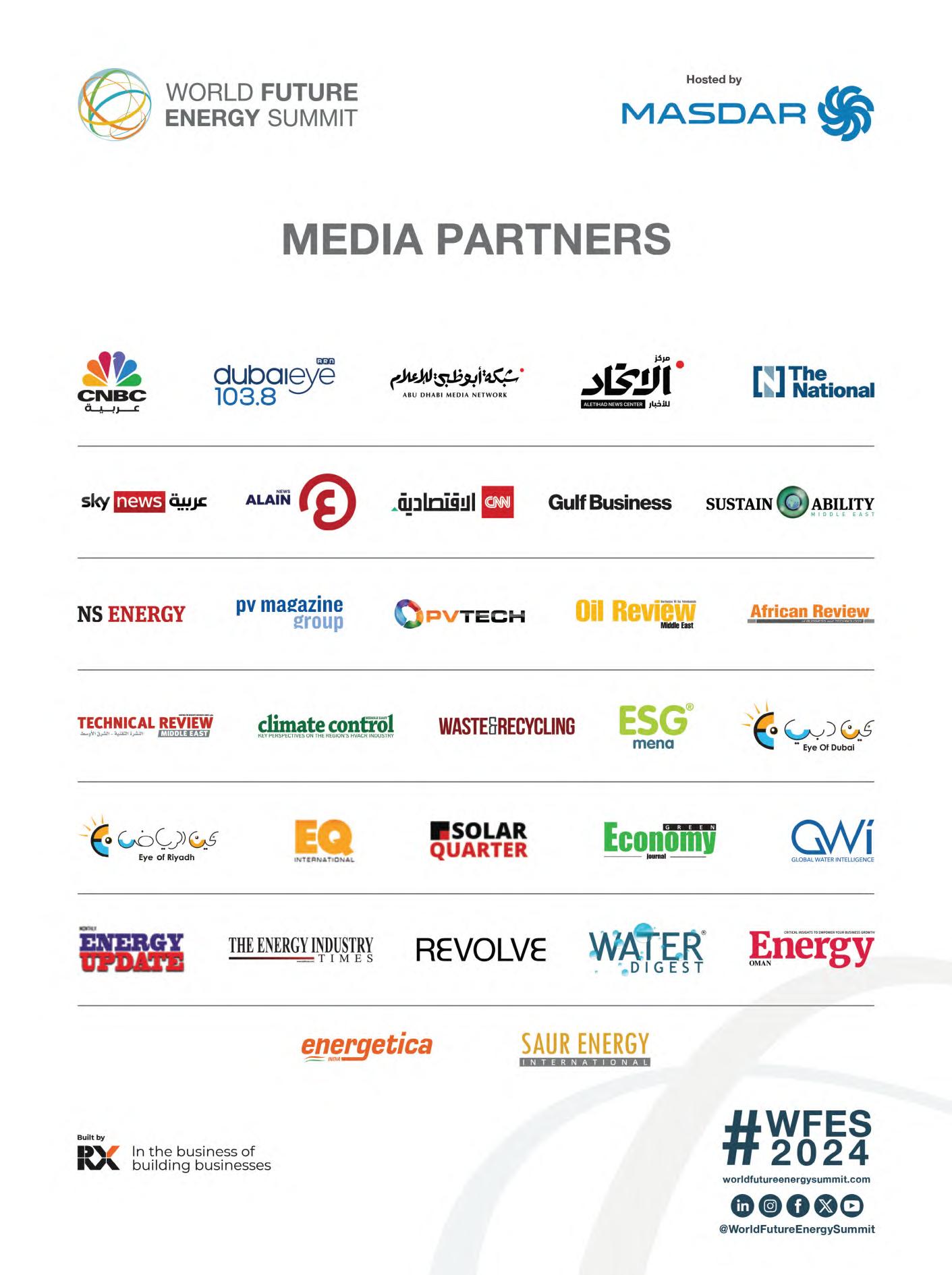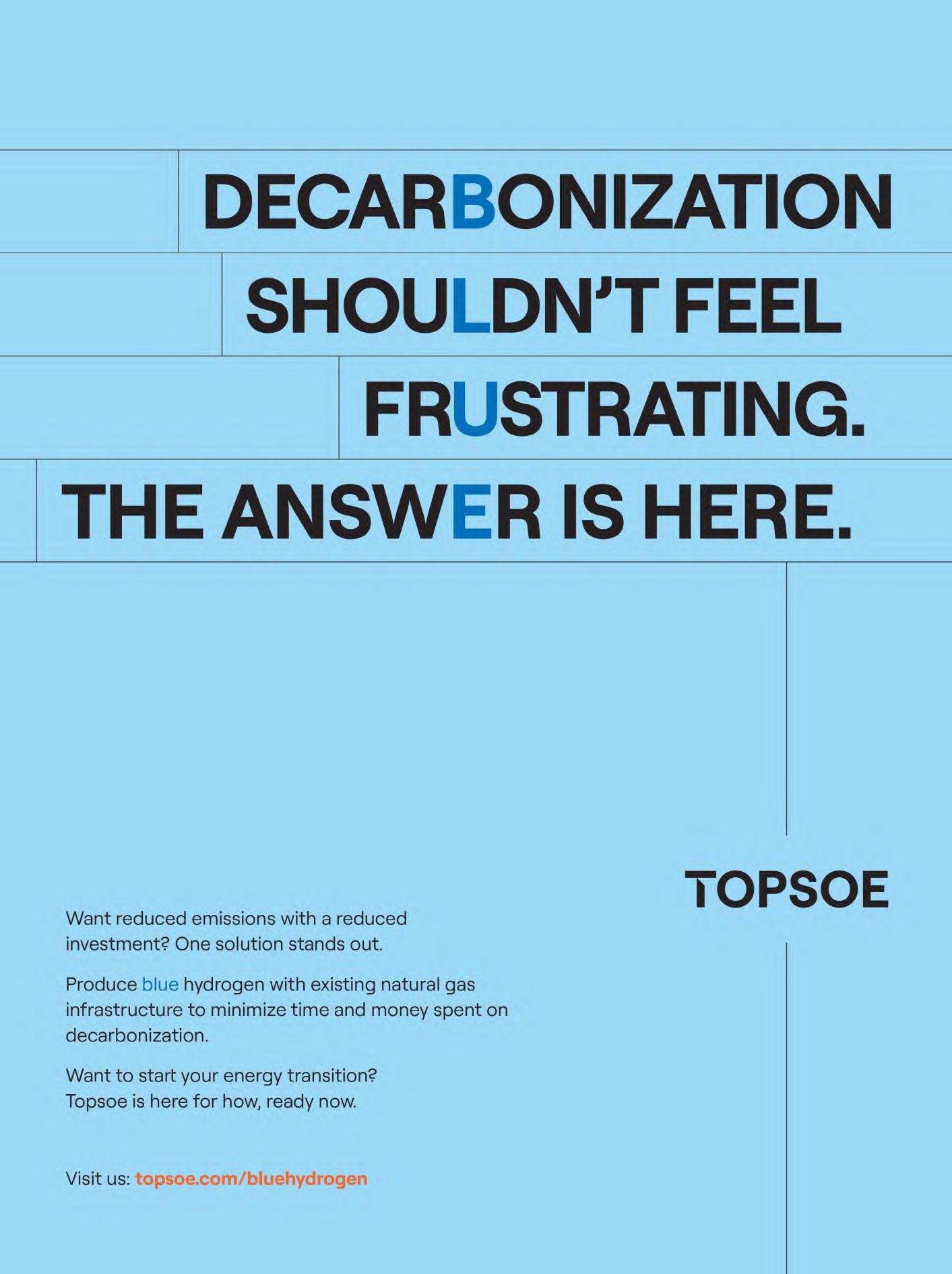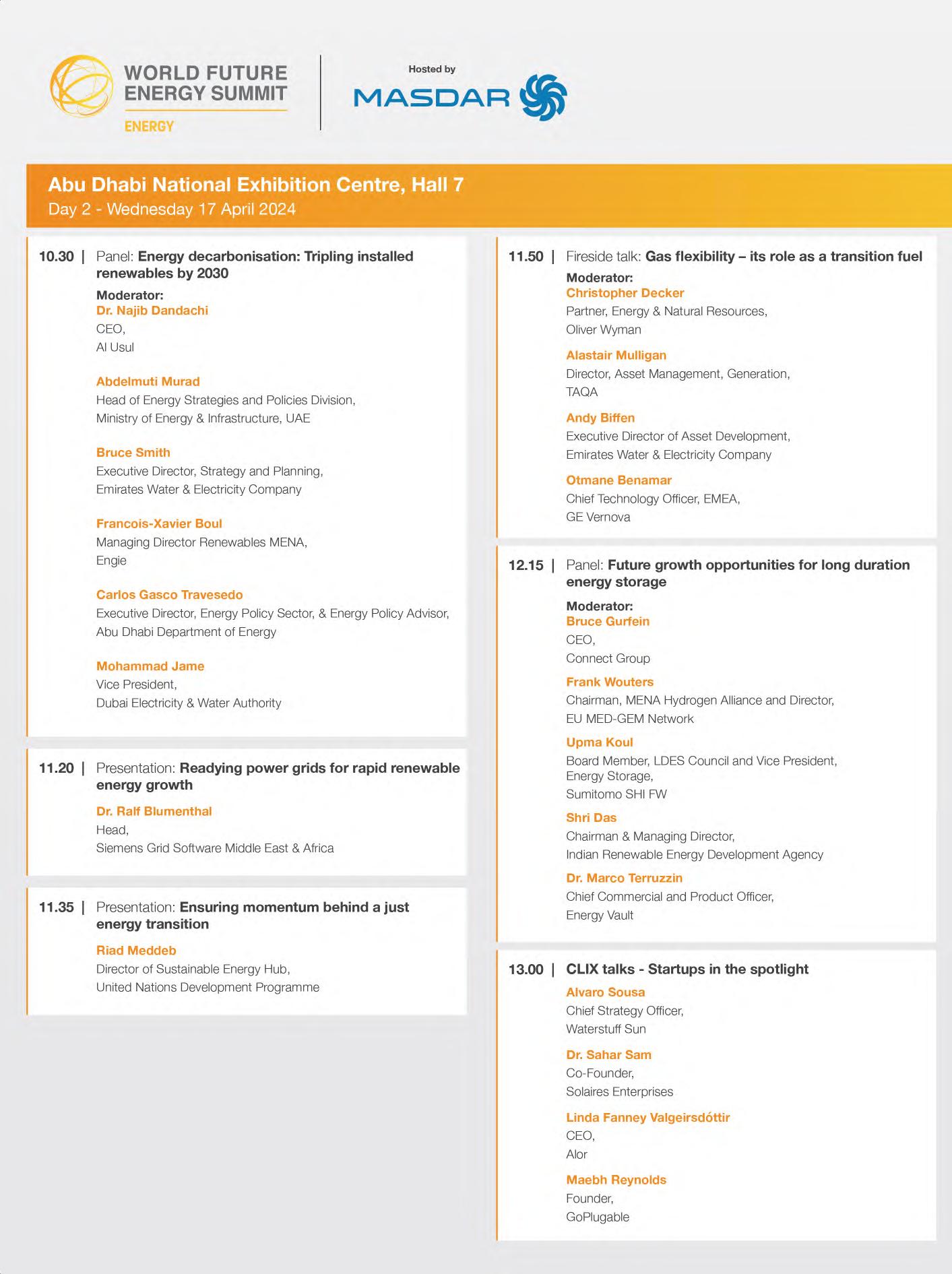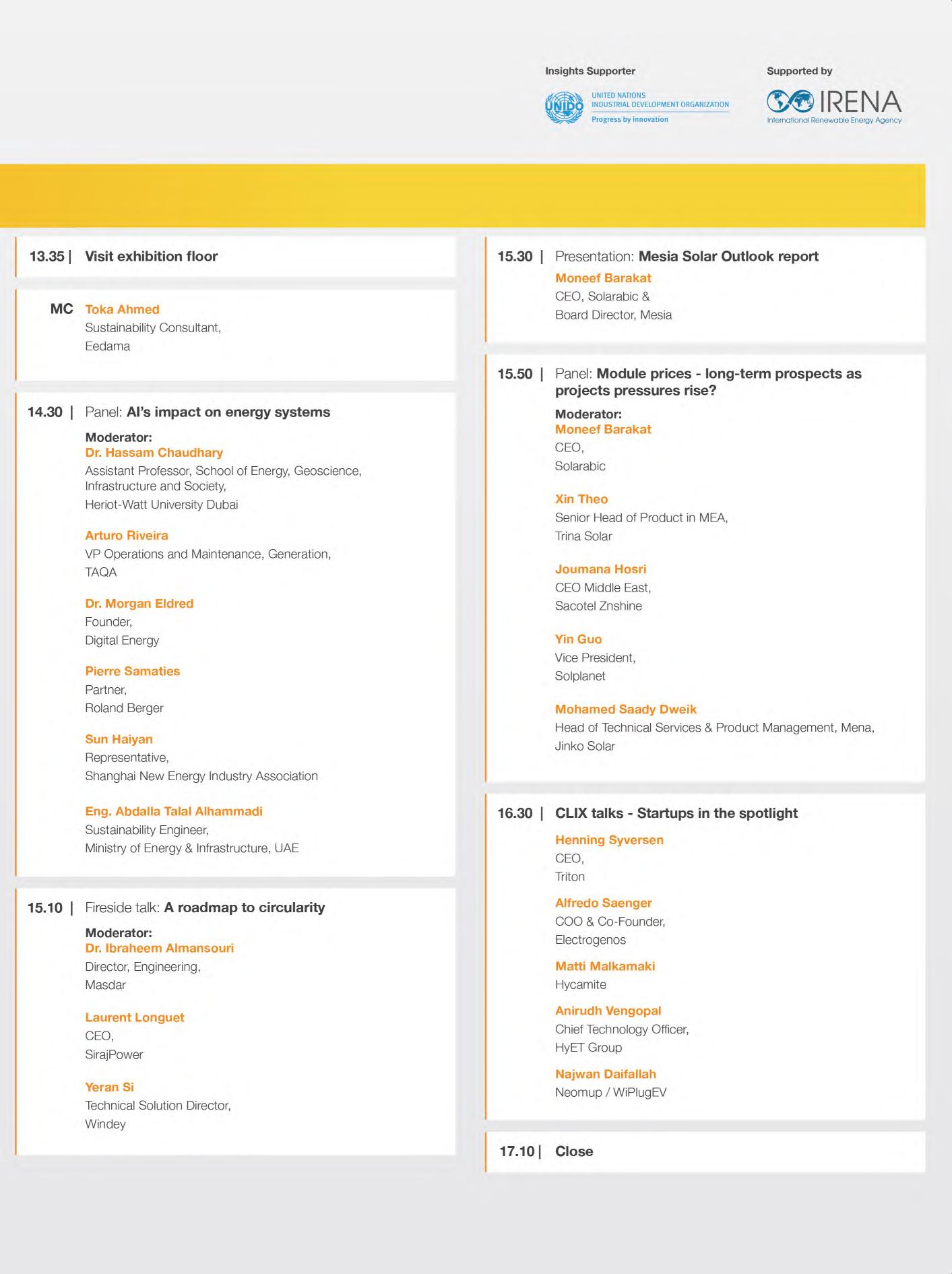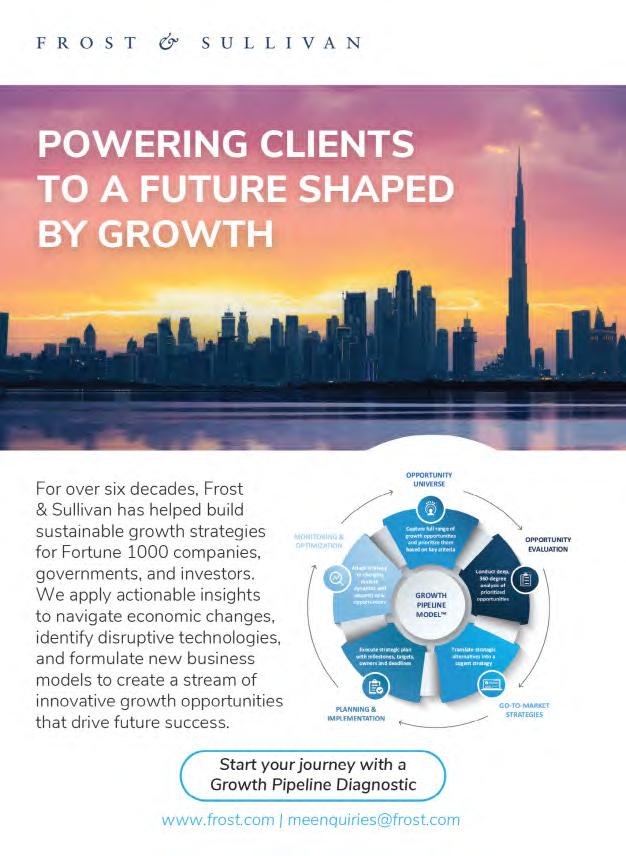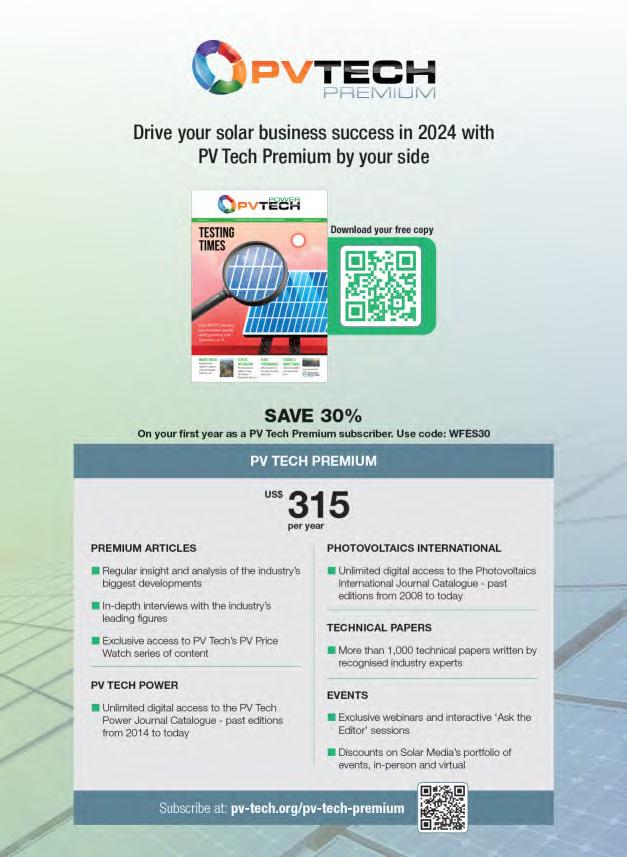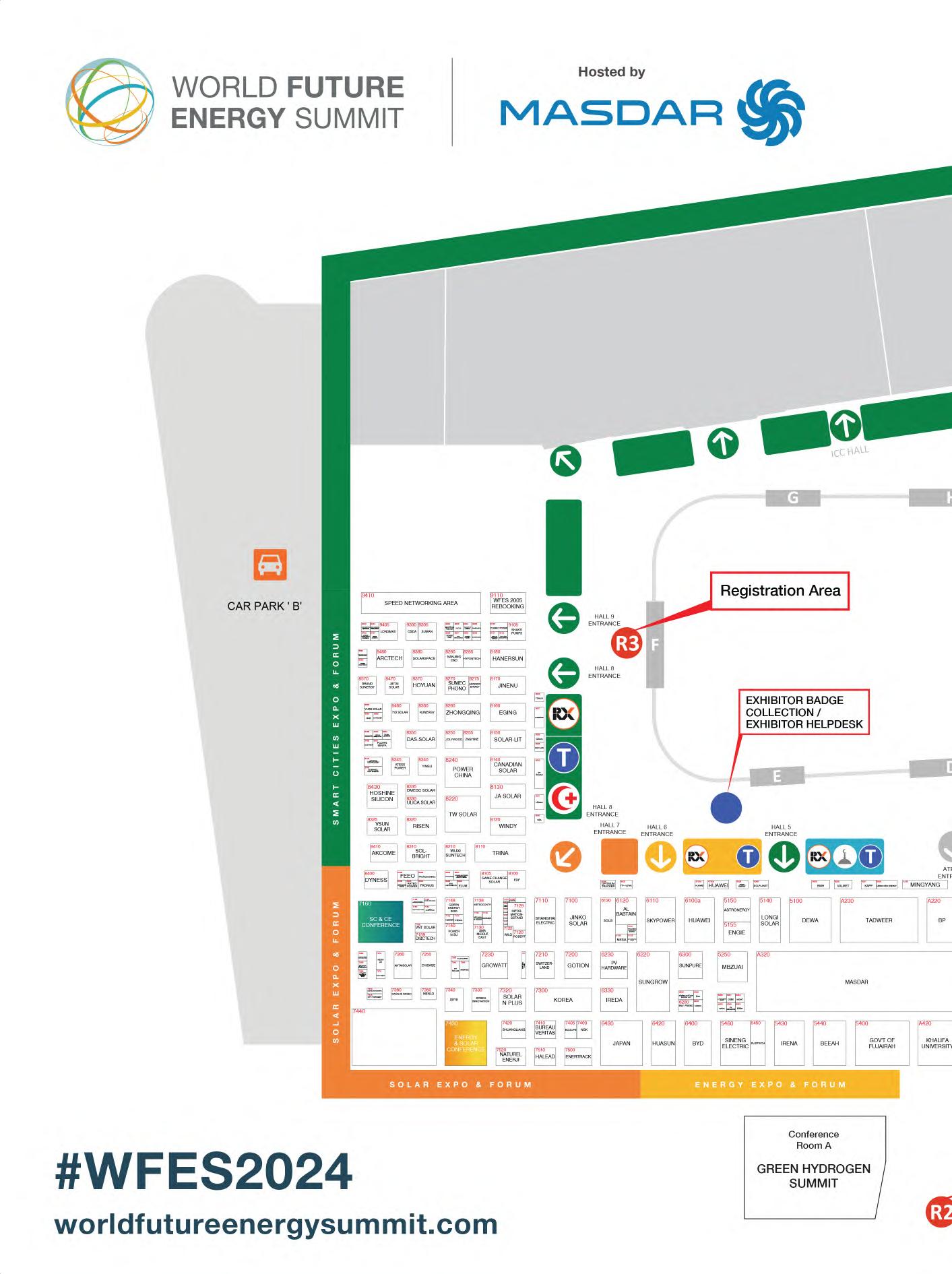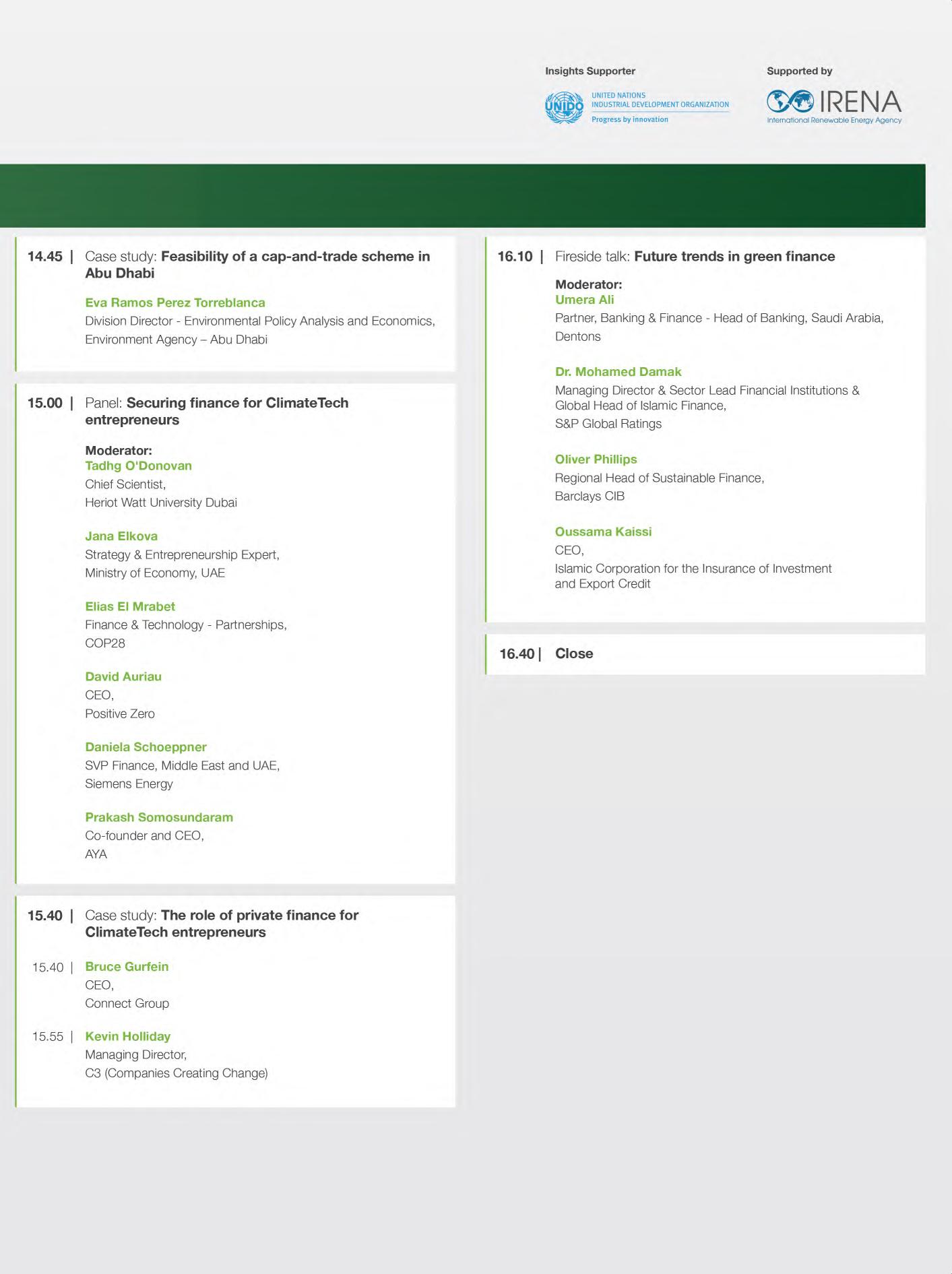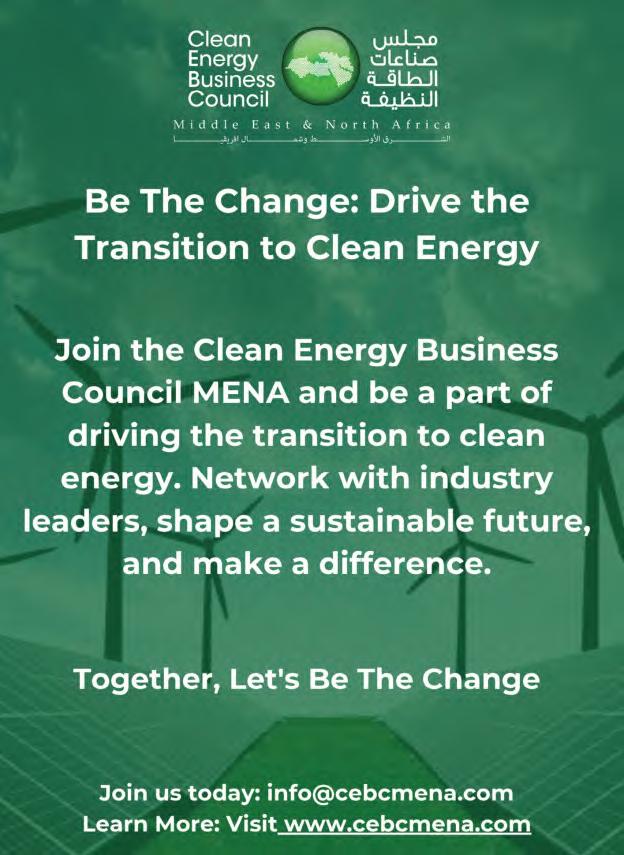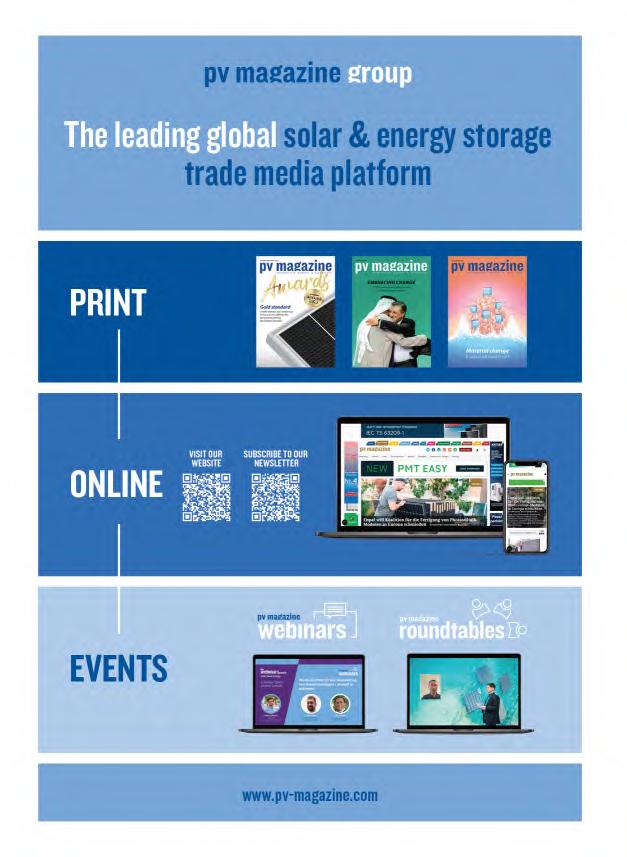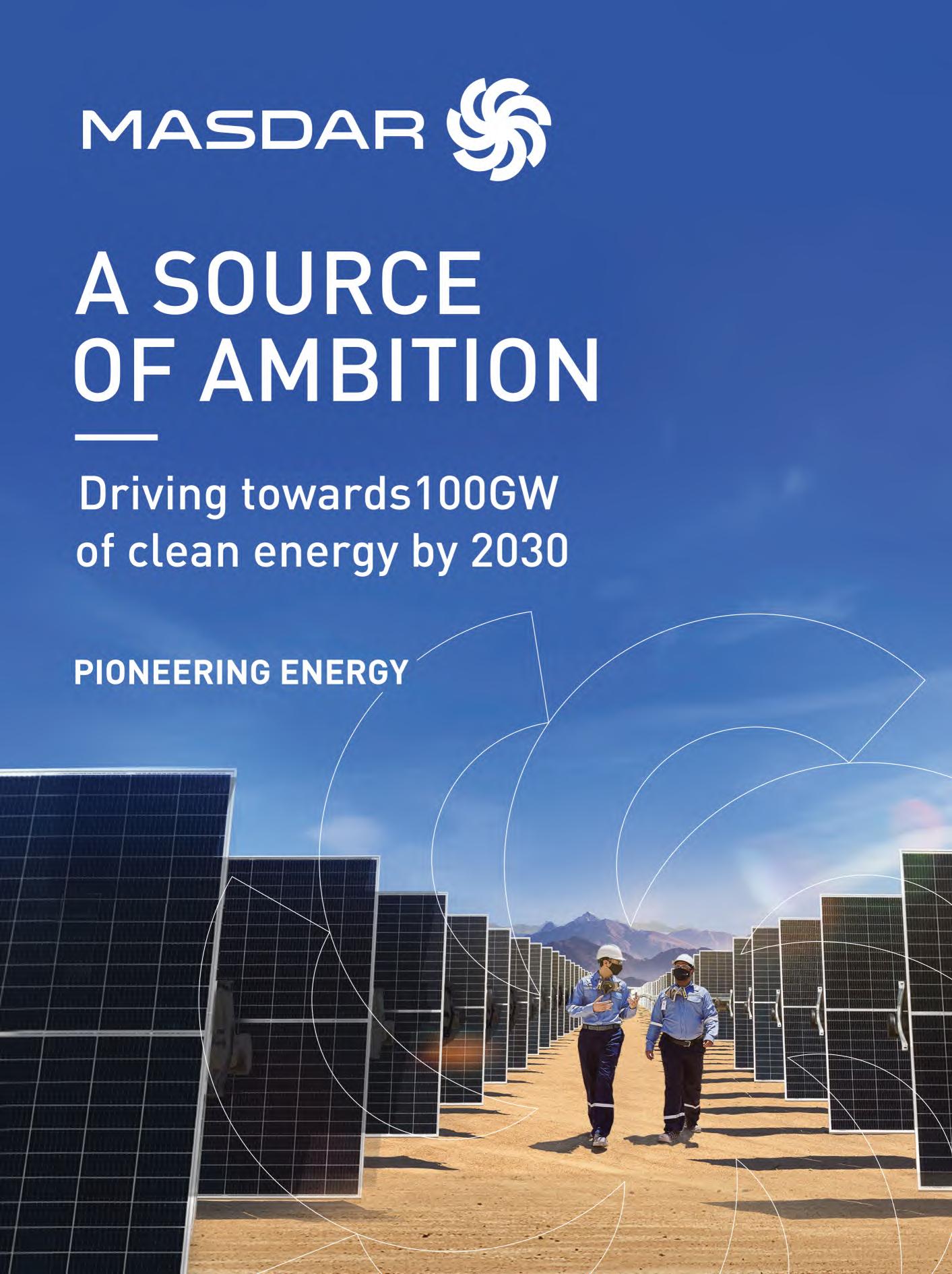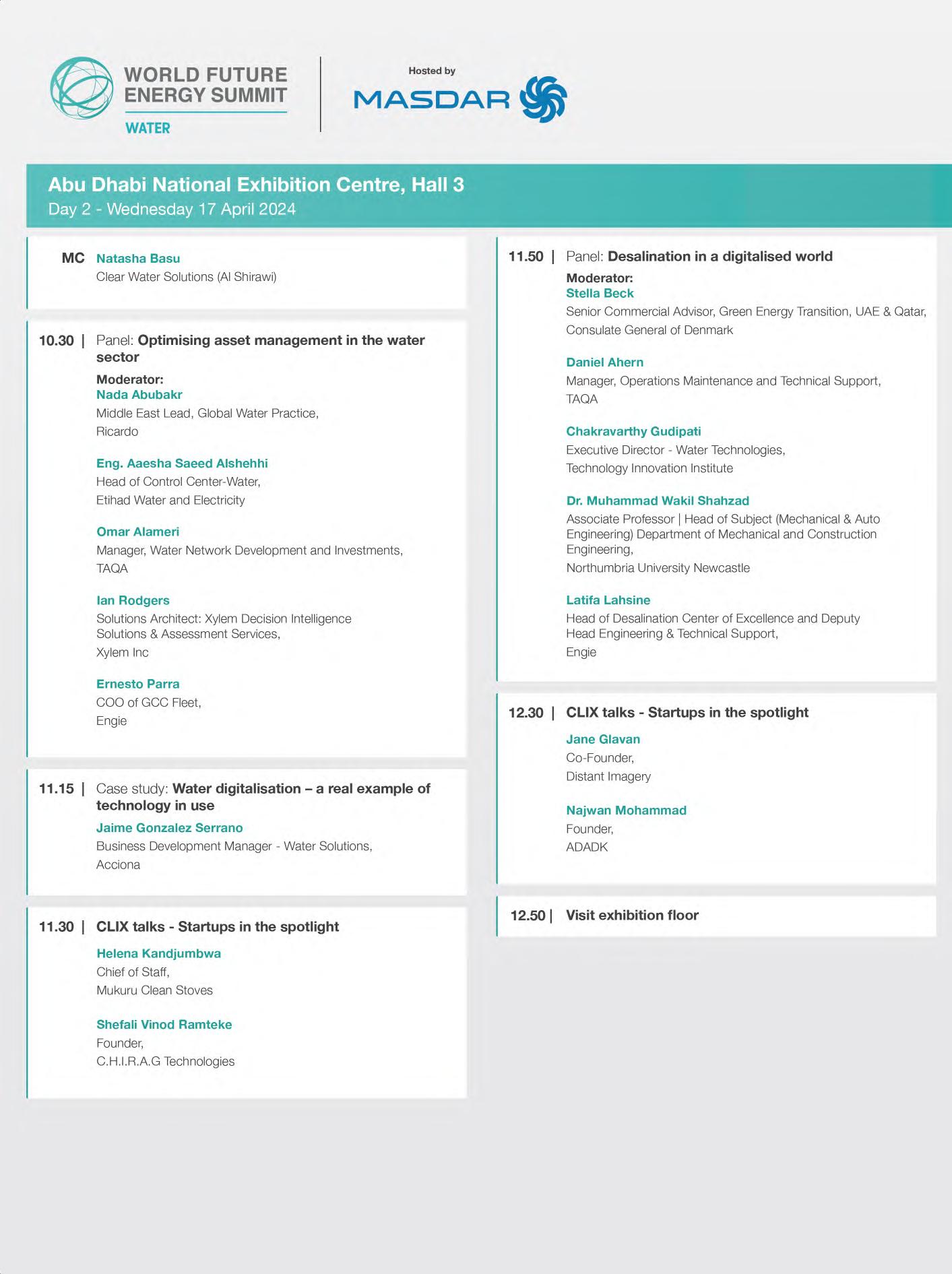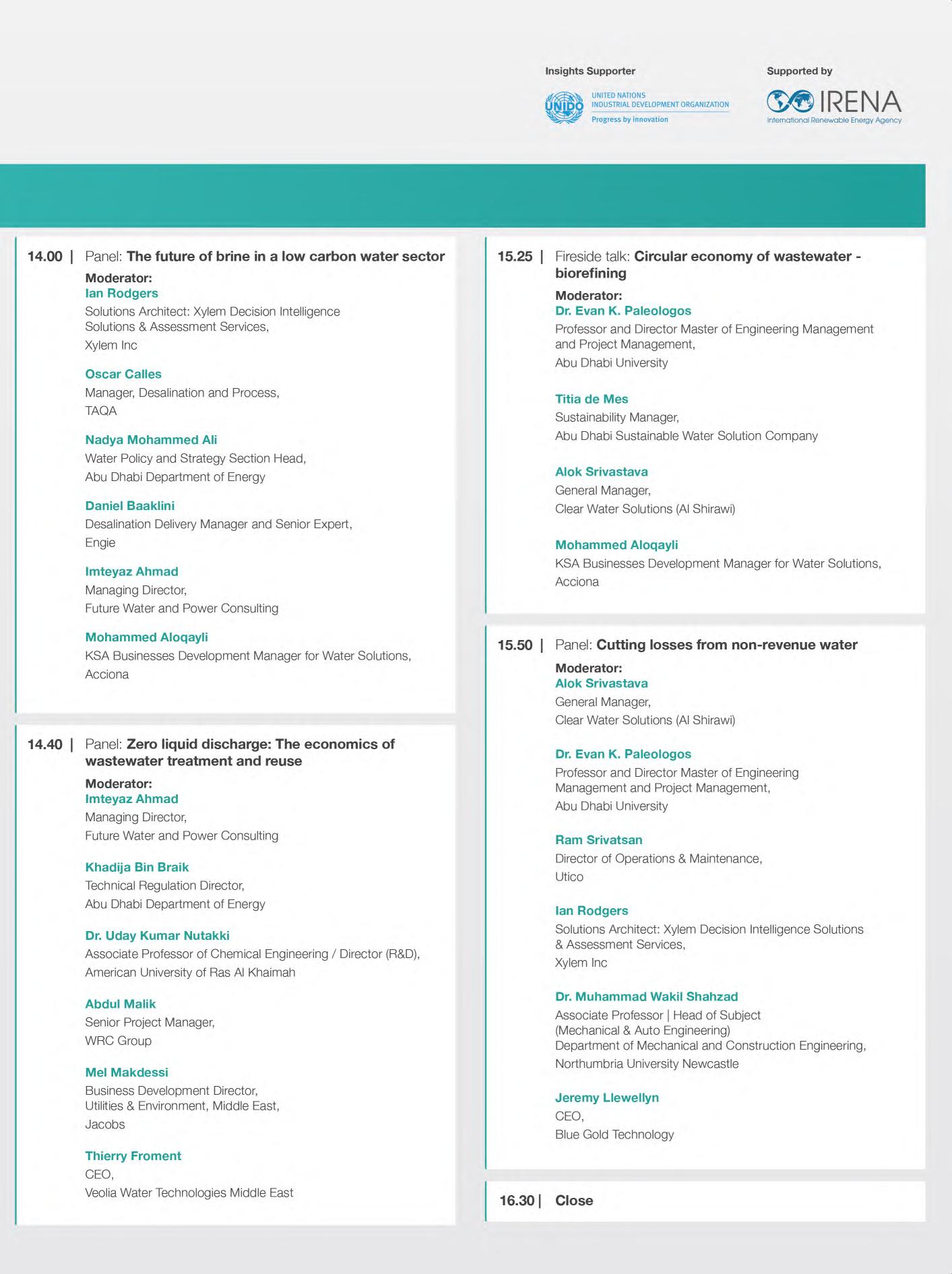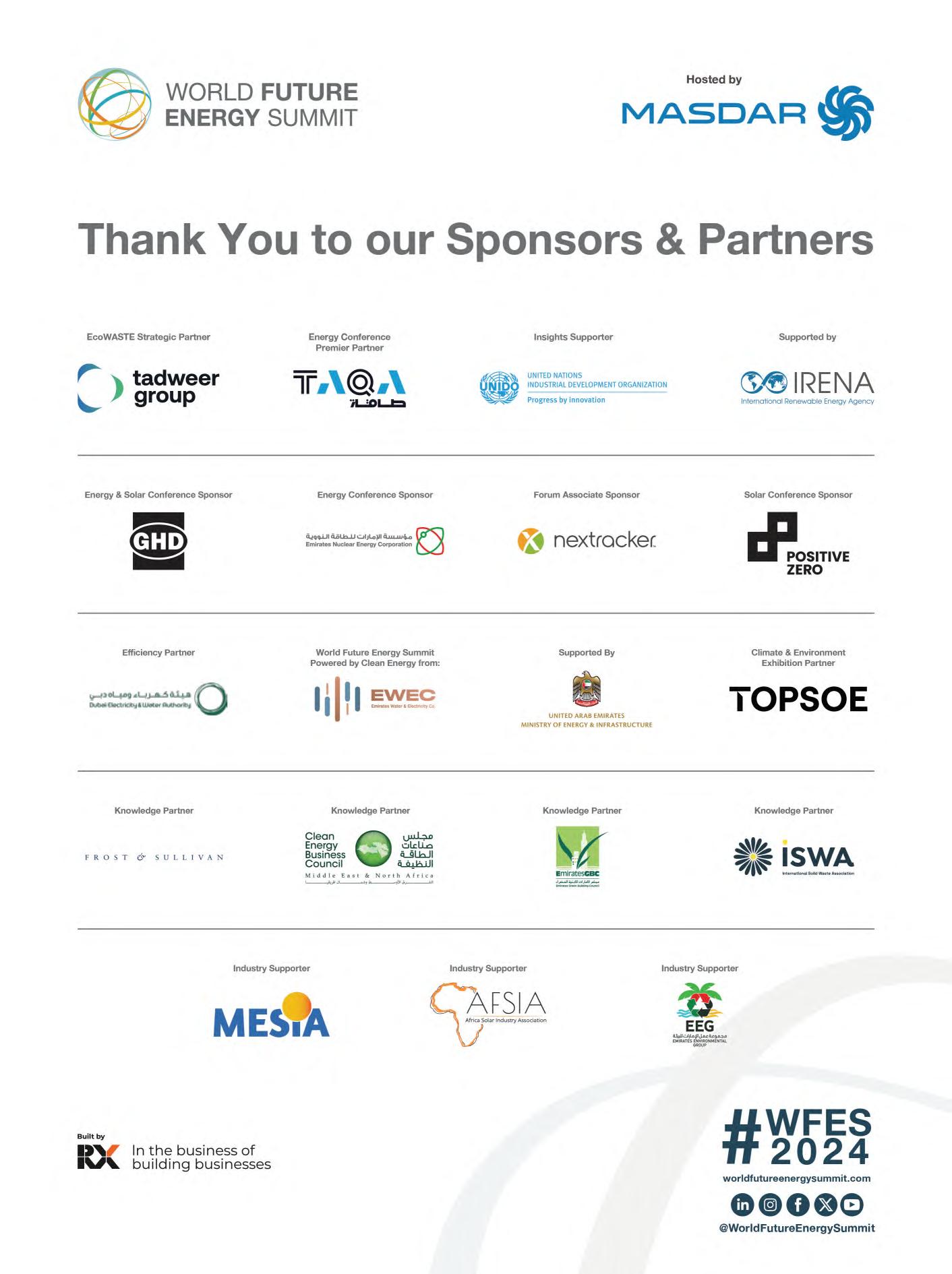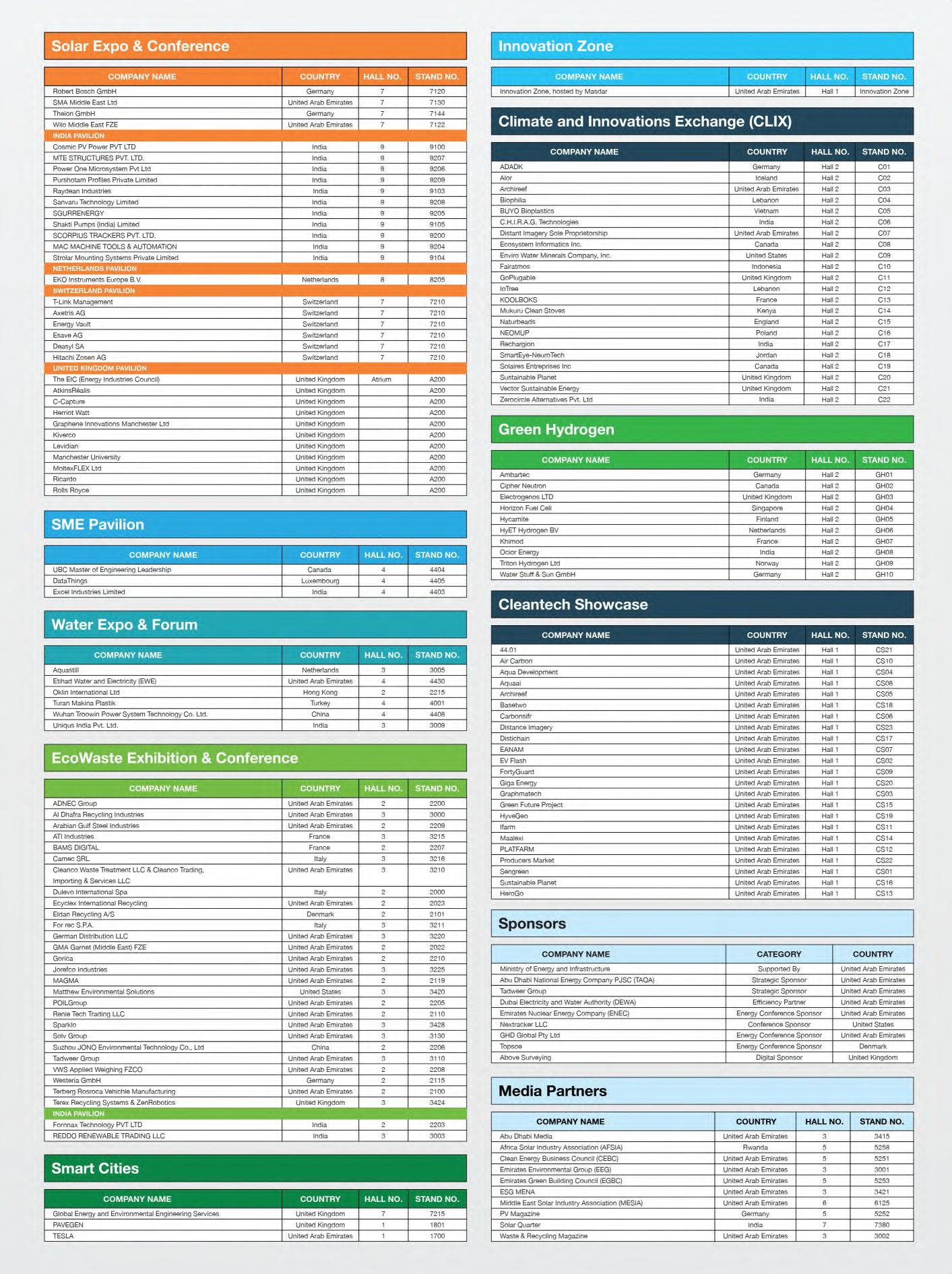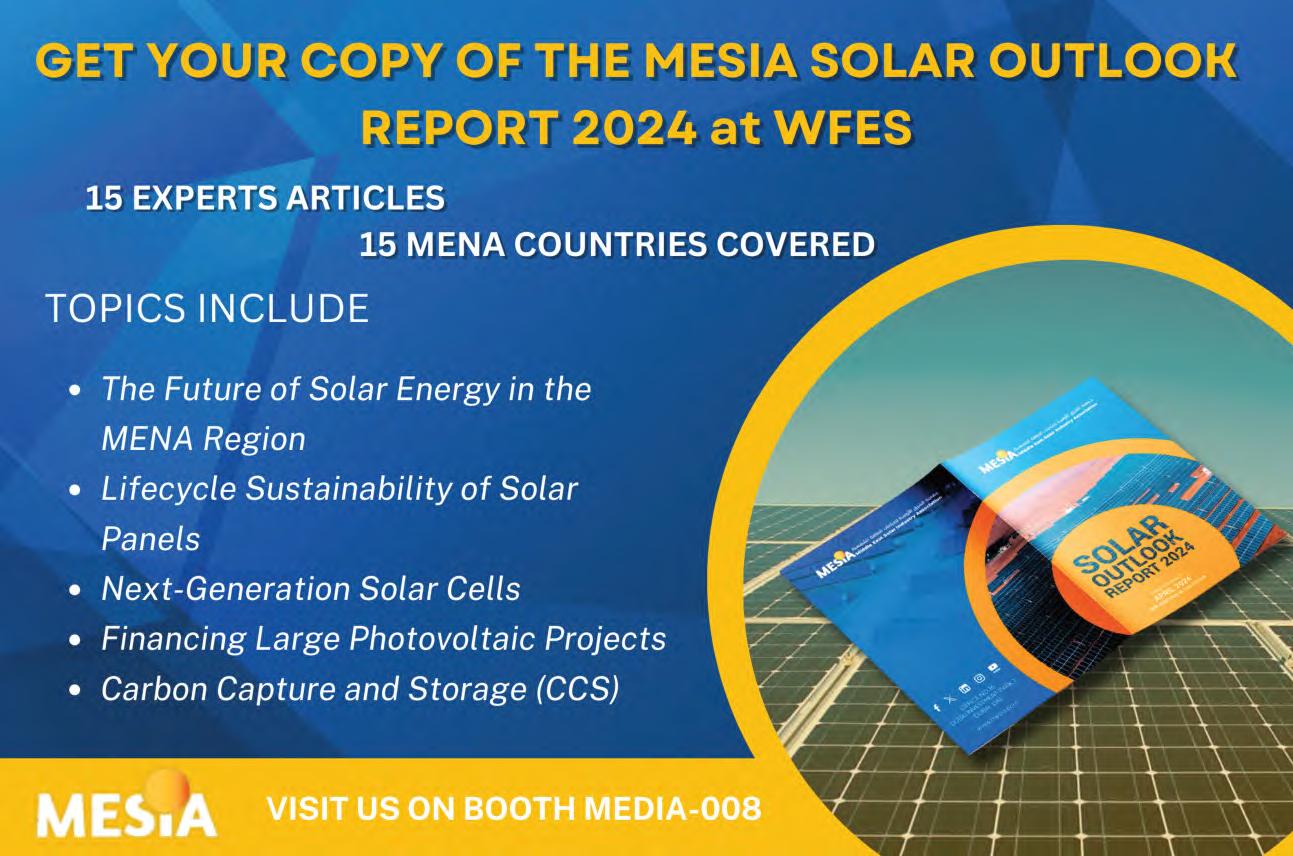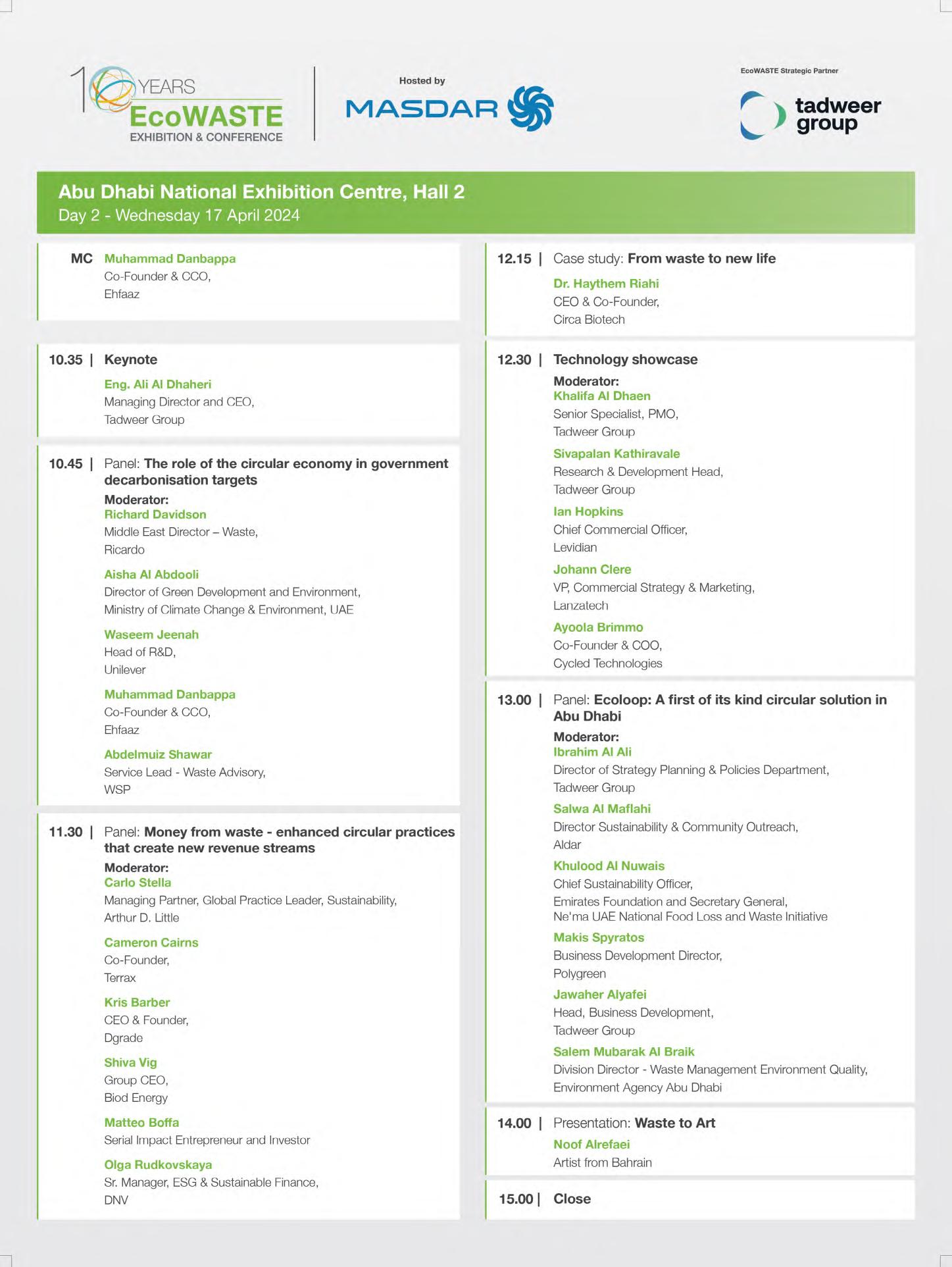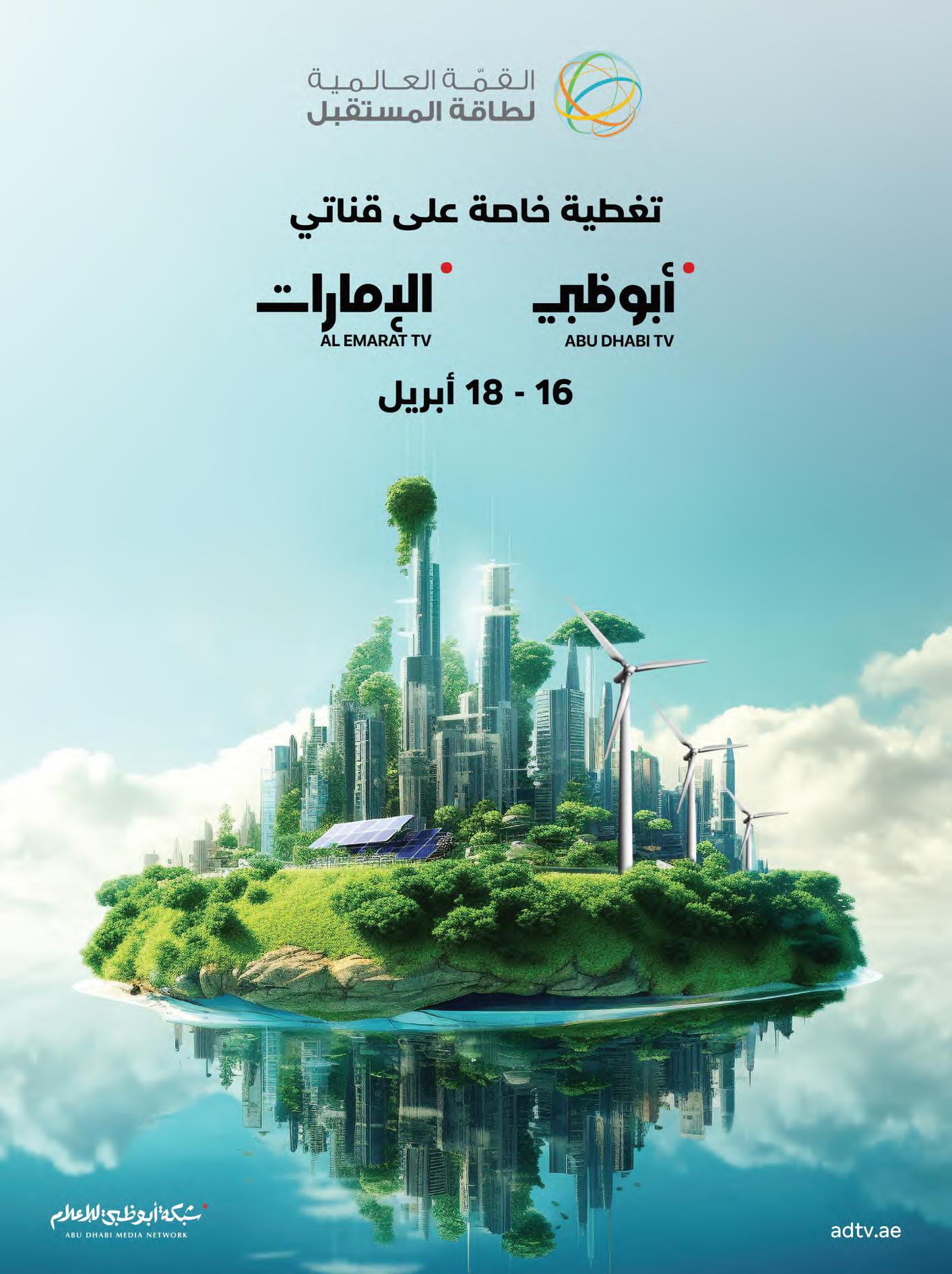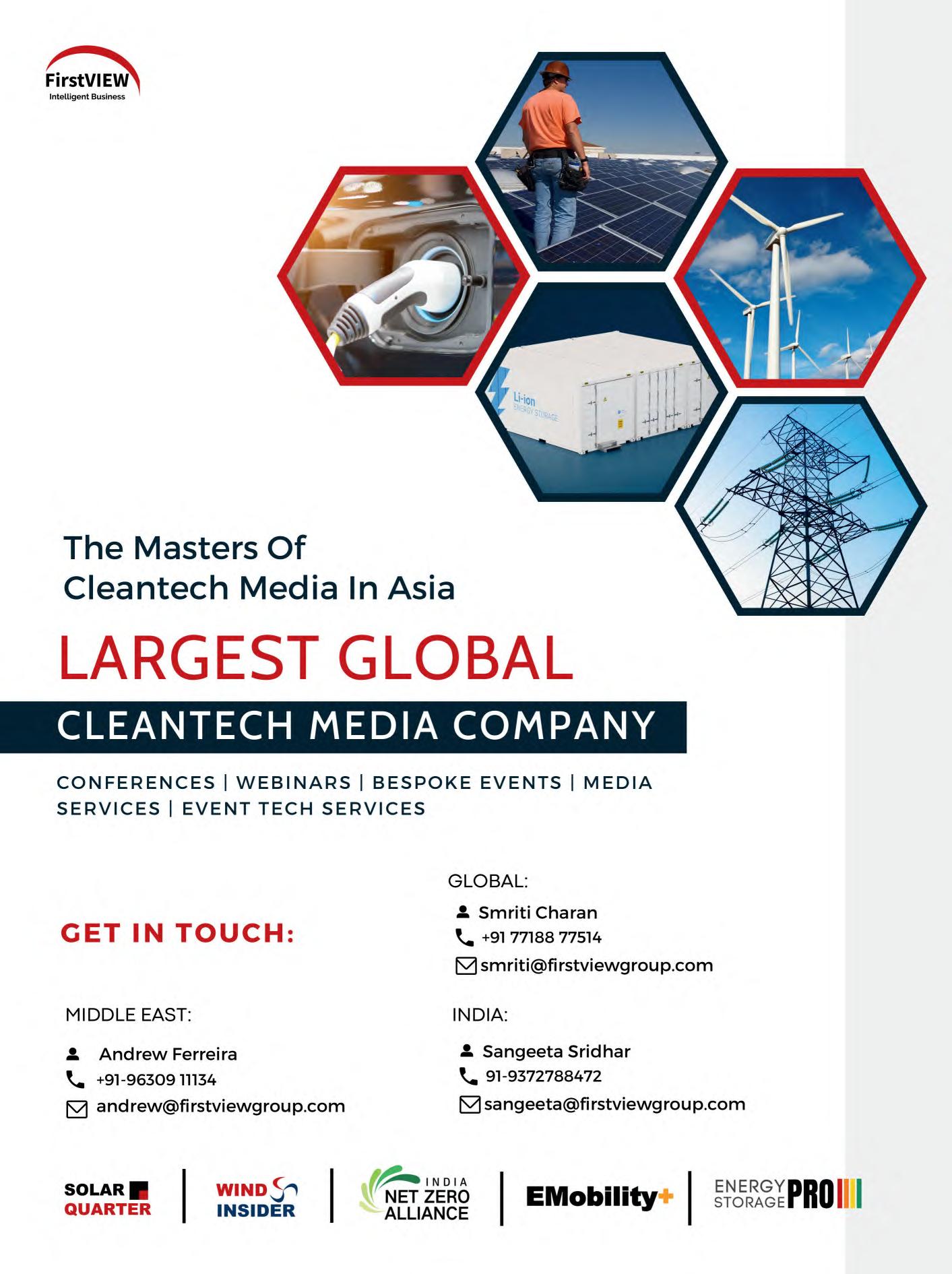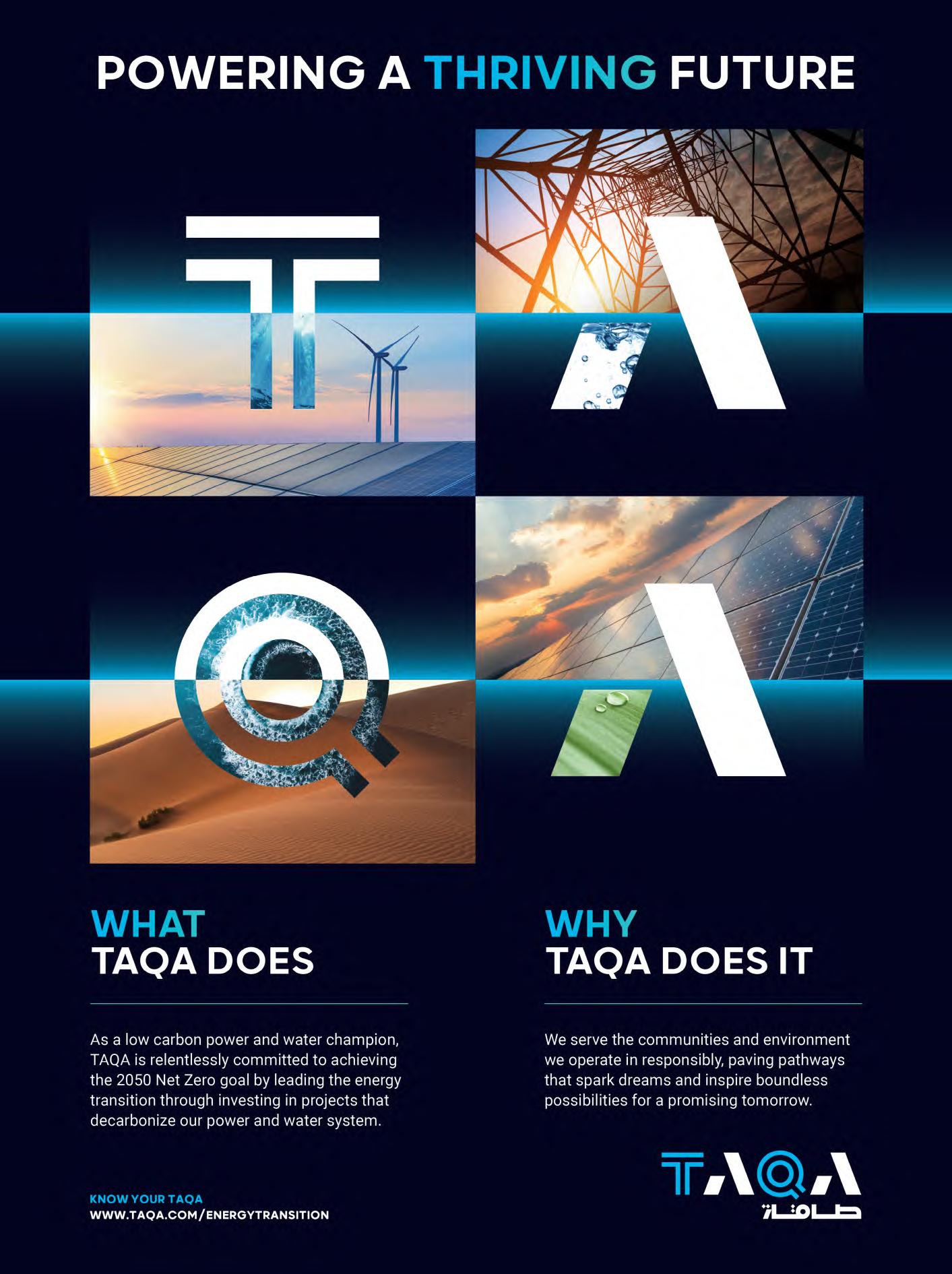DAY 2, 17 APRIL 2024
Today 01
World Future Energy Summit 2024 brings green finance to the fore
After earning notable attention by Her Highness Sheikha Shamma bint Sultan bin Khalifa Al Nahyan at the inaugural keynote of the World Future Energy Summit, the Green Finance Forum began in earnest on the second day of the event.
Elias El Mrabet, Climate Finance Director at COP28, opened proceedings, explaining that, “COP28 was incremental in terms of making finance more available, accessible and affordable, and to push global approaches to financing the transition towards carbon neutral.”
“COP28 pushed a different narrative of investment opportunity rather than a narrative of reparation.”
Hydrogen
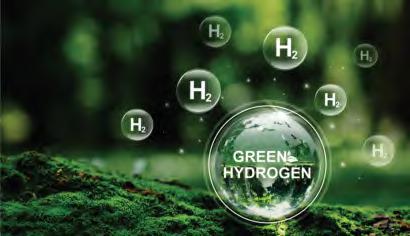
New green hydrogen report
Solarbic and MESIA launched their report ‘Unlocking the potential of green hydrogen’ at the World Future Energy Summit.
The race towards a sustainable future has never been more pressing, and green hydrogen technology has emerged as a key player in this transition. As the world shifts towards cleaner forms of energy, the importance of hydrogen in decarbonising various sectors cannot be overstated.
The report gives a comprehensive overview of the current state of green hydrogen technology, including updates on global developments, as well as a detailed analysis of the status of green hydrogen potential in the MENA region.
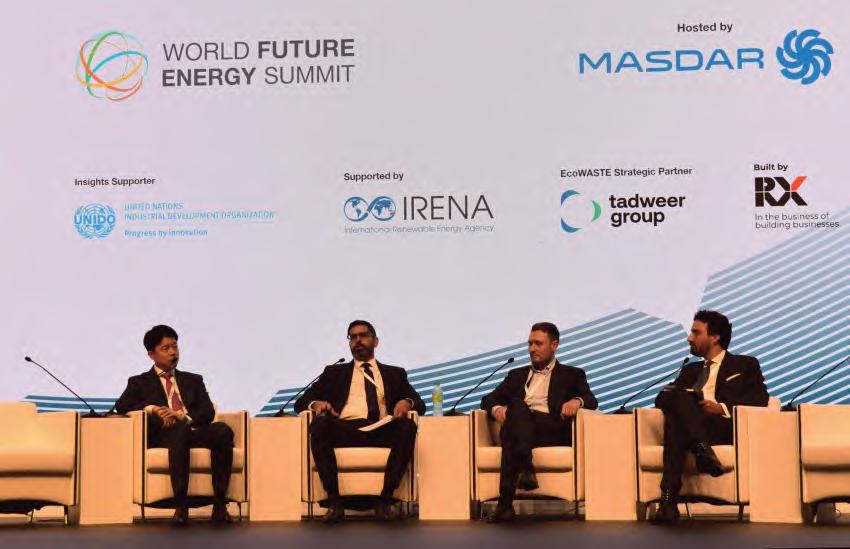

Business

Boosting business connections
At a meet and greet hosted by the World Future Energy Summit Sustainability Business Connects programme, a selection of exhibitors from the UK and Switzerland pavilions introduced their companies to international and local buyers. They ranged from an innovative nuclear technology, exhaust gas cleaning, laser gas detection, carbon capture and energy storage solutions, to waste-toenergy technology
“COP28 was incremental in terms of making finance more available, accessible and affordable.”
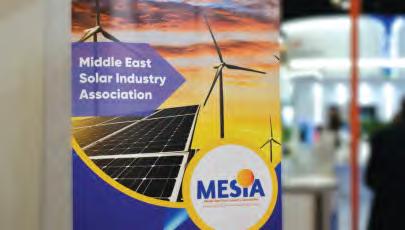
MESIA releases new report
The Middle East Solar Industry Association (MESIA) launched its Solar Outlook Report 2024 at the World Future Energy Summit. It provides valuable insights on the future of solar energy in MENA, the latest solar innovations and technological advances, and highlights of developments in the region’s leading solar PV markets. “In this year’s report, readers will delve into topics such as solar panel performance testing methods, which ensure efficiency and reliability in challenging environments. Additionally, insights from our government partner, DEWA, shed light on commercially viable Perovskite Silicon Tandem Solar Cells and the integration of solar power into the grid, supported by regional-scale solar mapping and forecasting initiatives,” said Denisa Fainis, Secretary General of MESIA in the Foreword. Solar
Organised by
DAILY NEWS
Hosted by EcoWASTE Strategic Partner Insights Supporter Supported by
(Left-right) The Japan Bank for International Cooperation’s Kenny Kitamura, GE Capital’s Ahmed Bahei-Eldin, Masdar’s Bruce Johnson, and COP28’s Elias El Mrabet opened proceedings at the Green Finance Forum.


“Inspired by the UAE’s climate ambition, Borouge is resolutely pursuing net zero in its own operations, aiming for an accelerated timeframe of 2045.”
Hazeem Sultan Al Suwaidi, CEO of Borouge
FLOORPLAN: Find your way around
EtihadWE: commitment, capitalising on momentum, and the private sector’s crucial role
Etihad Water & Electricity (EtihadWE) has committed to future action, issued a call to unlock multi-national potential, and emphasised that the private sector is “poised and ready” for a crucial role in the energy transition at 2024’s World Future Energy Summit.
The company committed to future collaboration opportunities and projects to enhance renewable energy adoption throughout the northern emirates by signing a memorandum of understanding (MoU) with Masdar.
Elsewhere, Eng. Yousif Al Ali, CEO of Etihad Water & Electricity, called on the industry to continue the momentum of COP28 and “facilitate the efficient exchange of resources between nations,” emphasising how multi-country corridors are key to “promoting regional stability and economic growth.”
“COP28 championed collaboration as the key to unlocking a greener future. Through strategic investments, countries can harness the benefits of cross-border synergy, promoting sustainable development and prosperity on a regional scale.”
Ahmed Alsuwaidi, Vice President – Asset Management, Etihad Water & Electricity, took part in a panel session, ‘What Water Privatisation Means for Regional Water Development and Security’, explaining, “The most vital component of a successful utility company is its ability to
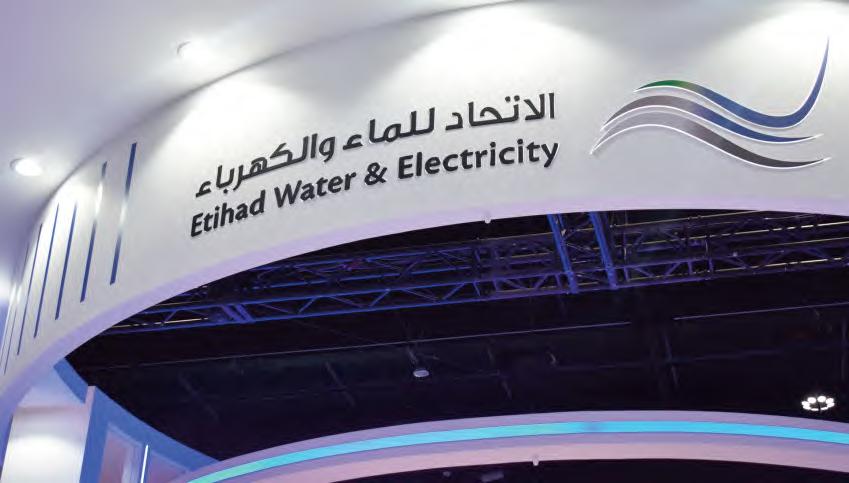
The agency has utilised the World Future Energy Summit as a platform to commit to future action, capitalise on the momentum of COP28, and emphasise the crucial role of the private sector.
consistently deliver for its customers. Prioritising efficient delivery and consistent innovation ensures a sustainable path to success.”
“Customers are the lifeline of any utilities company. Our growth and success as an industry comes from emphasising their needs and consistently delivering exceptional value.”
On the overall presence of Etihad Water & Electricity at World Future Energy Summit 2024, CEO Eng. Yousif Al Ali concluded: “We are driving social change by powering a cultural shift to frame water and electricity as the precious resources that they are and equipping our customers with the knowledge and tools to make more sustainable choices.”
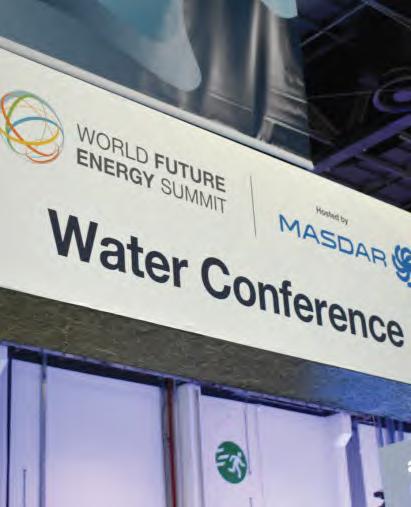
A global issue on an international stage
Dr. Najib Dandachi, CEO of Al Usul, welcomed crowds to the opening of the Water Conference at the World Future Energy Summit 2024. Before introducing H.E. Ahmed Alkaabi, Undersecretary Assistant for Electricity, Water & Future Energy Sector at the Ministry of Energy & Infrastructure, UAE, Dandachi revealed: “There are approximately 1.1 billion people worldwide without access to clean water and 2.7 billion experiencing water scarcity for at least one month each year.”
`While the global discussion continues to gain traction, H.E. Ahmed Alkaabi emphasised the national importance of discussions around water scarcity: ”For us in the United Arab Emirates, water is one of the most important national issues, given our geographical location, the scarcity of our national water resources and the high demand for water.”

It is not just conversation that will drive the UAE towards a more water-secure future, nor is it an unachievable dream, according to the Undersecretary Assistant for Electricity, Water & Future Energy Sector: “I am fully confident that the innovation we adopt, the discussion we will have, and the partnerships we will witness being built will take us closer to the collective objective of ensuring access to clean water.”
www.worldfutureenergysummit.com 3 DAY 2 | 17 APRIL 2024 DAILY NEWS
22
Water, “one of the most important national issues”, gets a fittingly strong presence at the World Future Energy Summit 2024.

“Unlocking Africa’s renewable hydrogen potential will require coordinated efforts across public and private sectors.
Sanjiv Lamba, CEO of Linde and Co-Chair of the Hydrogen Council
10 years
of EcoWASTE Exhibition and Conference
culminates in a "pivotal moment"
World Future Energy Summit 2024 has the privilege of hosting the 10th iteration of the EcoWASTE Exhibition and Conference. Held under the theme of 'Empowering a circular future', the Conference, and its strategic partner Tadweer Group, hopes to inspire conversations and advancements in the sustainable waste management sector.
Eng. Ali Al Dhaheri, Managing Director and CEO of Tadweer Group, described the opening of the EcoWASTE Exhibiton and Conference's 10th iteration as "a pivotal moment," welcoming "experts, thought leaders and changemakers in the field of waste management, all united in our shared pursuit of sustainable solutions for the future."
Eng. Ali Al Dhaheri spotlighted last year's iteration of the UN Environment Programme Report which revealed that municipal solid waste generation is on track to grow to 3.8 billion tonnes by 2050: "a stark reminder of the challenges that lie ahead," according to Tadweer Group’s CEO, but also a
high-value opportunity for stakeholders in the waste management sector. "It is through collaboration and collective effort that we can truly make a difference."
The three days of the EcoWASTE Exhibition and Conference promise "insightful sessions, workshops, and discussions that promise to offer invaluable insights and actionable strategies."
“As we embark on this journey together, it is imperative to recognise the profound impact the waste management sector has on our environment and our communities. As we grow, we firmly believe that waste is not a burden to be disposed of, but rather a valuable resource waiting to be harnessed. This belief forms the cornerstone of our approach as we work tirelessly to promote the transition to a circular economy. By unlocking the value of waste, we can create opportunities for economic growth, environmental protection and community resilience,” Eng. Ali Al Dhaheri concluded.
Innovative technology harnesses energy from footsteps
Pavegen is showcasing its Pavegen Energy Floor System at the World Future Energy Summit. The system harnesses the power of kinetic energy by converting footsteps into electricity, using a series of interlocking tiles that depress slightly when stepped on, concerting the vertical force of the step into rotational motion. This motion drives an electromagnetic generator, producing clean and sustainable energy. By embedding Pavegen tiles within high footfall areas, such as public spaces or transportation hubs, cities can tap into the vast potential of human movement to generate
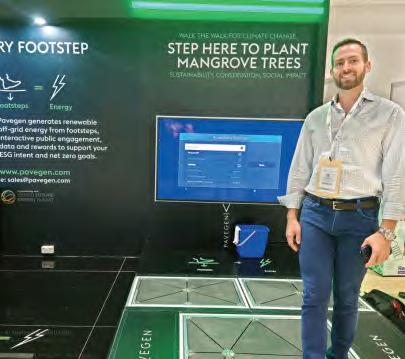
electricity. The system is currently installed in around 25 countries around the world, from transport hubs in London to public spaces in the UAE.
Beyond its energy generation capabilities, Pavegen serves as a powerful tool for engaging citizens and promoting sustainable behaviours. By incorporating Pavegen tiles in public spaces, citizens are encouraged to actively participate in the energy generation process, giving them an awareness of the potential for renewable energy and the positive impact on the planet of sustainable actions in the drive for net zero. Laurence Kemball-Cook, CEO of Pavegen, said, “We have worked with dozens of brands around the world. Where we’ve seen a lot of success is using it as a tool to communicate a very simple, powerful message and get people to engage. Sustainable energy and the change we are going through can be abstract and hard to grasp, so brands are using it to get people to care, communicate our message and convey a very simple idea, that every step forward is a step towards the future.”
At the Summit, the footsteps and subsequent energy produced are being tied to an environmental cause – reforesting mangrove trees in the UAE, with a goal of planting 100 million trees by 2030 to achieve climate neutrality.
MEDIA PARTNERS:
The organisations getting the word out

Tadweer Group’s Managing Director and CEO described the EcoWASTE Exhibition and Conference’s opening as a “pivotal moment.”
Masdar and EGA alliance
Masdar and Emirates Global Aluminium (EGA) have agreed an alliance to work together on aluminium decarbonisation and low-carbon aluminium growth opportunities.
Masdar and EGA will explore the joint development of renewable energy projects, with potential battery storage and green hydrogen production and storage, to support the decarbonisation of EGA’s existing operations in the UAE, and any future operations in the country. The two companies will work together internationally to find opportunities through which Masdar will support EGA to power new aluminium production facilities with renewable energy sources.
Mohamed Al Ramahi, Chief Executive Officer of Masdar, said, “Masdar is proud to be collaborating with EGA to help decarbonise the aluminium production process. Strong partnerships such as this are exactly what the world needs to accelerate our path to Net Zero. When organisations combine their knowledge and resources to help decarbonise vital industries, we not only protect the environment but we also boost the economy. This is core to our mission at Masdar. We look forward to developing further compelling propositions for international markets to maximise the economic benefits of using renewable energy.”
DAY 2 | 17 APRIL 2024 DAILY NEWS World Future Energy Summit | Daily News 4
14
Laurence Kemball-Cook, CEO of Pavegen at the Pavegen stand.

“When organisations combine their knowledge and resources to help decarbonise vital industries, we not only protect the environment but we also boost the economy.”
Mohamed Al Ramahi, Chief Executive Officer of Masdar
EXHIBITOR LIST: Who’s at the show
Female entrepreneurs shine at the World Future Energy Summit
Female entrepreneurs are taking centre stage at the Climate Innovations Exchange (CLIX) this year at the World Future Energy Summit.
Nisrine El Turky, founder and CEO of IOTree showcased her company’s IOTree device, which uses artificial intelligence and Internet of Things (IOT) to make the agriculture sector smarter. “It communicates with trees to detect pests at an early stage, so we can tell the farmer which pesticides to use and where on the farm to spray them. We also have other products for smart irrigation systems, and a complete solution for traceability and farm management.”
The IOTree technology is being deployed via around 3,000 devices in Lebanon, and in the Netherlands. The company is now looking to expand into the Gulf region.
Shirook Ali, CEO and Founder of Canada-based Ecosystem Informatics Inc, highlighted her company’s air quality monitoring and management solution, a mobile device which takes around 14 greenhouse gases and air quality measurements and provides real-time data and alert systems to provide insights and assist with decision-making. It can be installed on any platform such as vehicles, fences or poles. “We heard at this event about the importance of collaborating, collecting data and taking action. We are now looking to get into the Middle East. They have aggressive plans to take
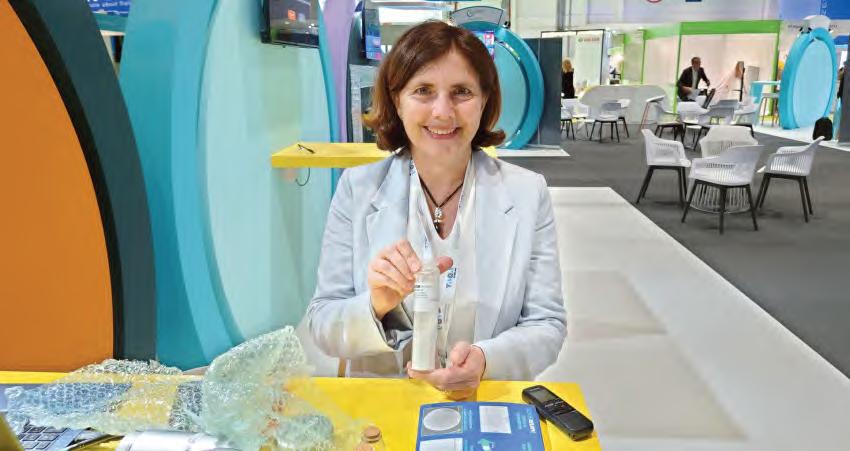
action, and we would love to be part of the solution and the support, because we are an impact-driven company focusing on sustainability and the future,” Shirook Ali concluded.
Naturbeads, a UK-based startup, is commercialising a technology developed at the University of Bath, addressing the issue of microplastics. These are found in many everyday products, from cosmetics to detergents and furniture coatings, and cause damage to the environment and human health. The Naturbeads
His Excellency commented that a just and sustainable transition in energy is essential for fostering energy security.
Dr Giovanna Laudisio, CEO and co-founder of Naturbeads, demonstrates the company’s biodegradable alternative to microplastics.
plant-based solution is made from cellulose, which is biodegradable and causes no harm to the environment. “Our solution is focused on prevention and end of life; we need to rethink the material we use,” said Dr Giovanna Laudisio, CEO and cofounder of Naturbeads. The solution can be used in many different applications. “When used in cosmetics our solution provides a smooth and luxurious feel on the skin, while when used in coatings, it provides scratch resistance, so has a lot of different properties.” The solution is expected to be in production next year.

Taking decarbonisation challenges head-on
On the first day of the Summit, H.E. Eng Sharif Al Olama, Undersecretary for Energy and Petroleum Affairs, Ministry of Energy & Infrastructure, kicked off the Solar & Clean Energy Conference with a poignant reminder that “energy poverty remains a sad reality.” This, he continued, was one of the primary reasons the energy community is gathering in Abu Dhabi this year. While he noted that the momentum established over the past few years around the energy transition should be celebrated, the world is currently falling behind the 1.5°C threshold, and some argue that even 2°C will be a challenge.

Nevertheless, Al Olama returned to the positives, reflecting on the progress the UAE has made in relation to clean energy. Among the achievements listed was the country increasing its renewable energy capacity from 1.8 GW in 2018 to 6 GW today; the fourth reactor at the Barakah Nuclear Energy Plant coming online (which will help the facility to cover around 25% of the UAE’s electricity needs); and the launch of the National Hydrogen Strategy, expected to produce 1.4 million tons of hydrogen per annum by 2031.
While the path to decarbonisation will undoubtedly be hard and full of challenges, Al Olama assured the audience that “we, in the UAE, are taking it head-on and we do believe that the rewards are substantial.”
www.worldfutureenergysummit.com 5 DAY 2 | 17 APRIL 2024 DAILY NEWS
34
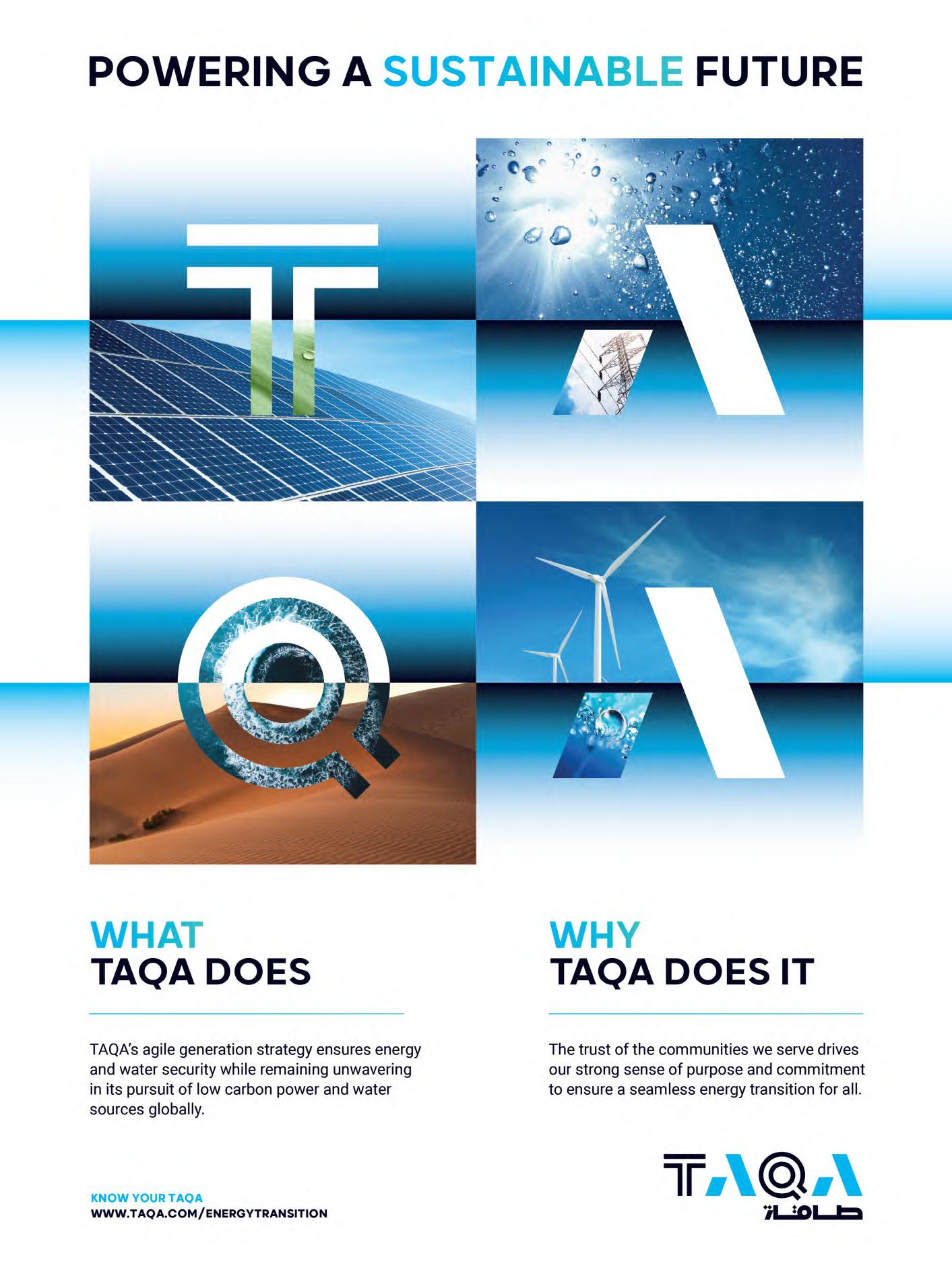

“Forums such as this offer crucial opportunities for actors from different sectors to exchange views, sparking ideas and collaborative action.”
Her Highness Sheikha Shamma bint Sultan bin Khalifa Al Nahyan, President & CEO, UICCA
SOLAR NEWS: How solar is shifting Africa’s energy landscape
EWEC & Tadweer Group confirm international partners for waste-to-energy facility
Emirates Water and Electricity Company (EWEC) and Tadweer Group recently signed a concession agreement with a consortium of Japanese industry partners (Marubeni Corporation, Hitachi Zosen Inova, and Japan Overseas Infrastructure Investment Corporation for Transport & Urban Development), confirming the global organisations as partners for the development of the world’s most advanced waste-to-energy facility, in Abu Dhabi, striving to set a new global benchmark of productivity, innovation and sustainability.
Expected to be one of the region’s largest and the world’s most advanced hubs of its kind, the wasteto-energy facility will annually process up to 900,000 tonnes of waste, contributing to a carbon emissions reduction of 1.1 million tonnes each year.
Othman Al Ali, CEO of EWEC, described the agreement as “a milestone for Abu Dhabi and the UAE as we continue to accelerate the decarbonisation and sustainable transformation of the country’s economy.”
Tadweer Group’s CEO and Managing Director, Eng. Ali Al Dhaheri, added, “This concession agreement marks a new chapter in our mission to promote environmental sustainability and implement accelerated technology, showcasing the importance of waste conversion to clean energy. This project is a cornerstone in our strategy to reduce reliance on landfills, lower carbon
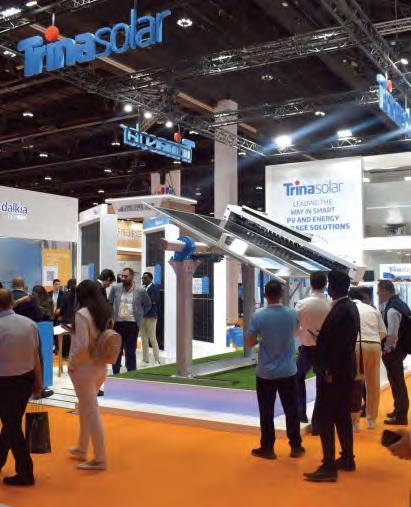

Othman
emissions, and support the UAE's energy agenda. We look forward to working closely with our partners to harness pioneering technologies that transform waste into valuable resources.”
Tadweer Group’s sustainable ambitions include the goal to divert 80% of Abu Dhabi’s waste from landfills into projects such as the upcoming waste-
to-energy facility by 2030, drafting a blueprint for alternative energy sources.
Isao Suzuki, Marubeni Corporation’s Regional CEO for the Middle East, added that the project is “a pivotal initiative that embodies our commitment to sustainable development and environmental stewardship.”
Trina Solar commits to shaping the region's renewable future
It is not only a suite of vertically-integrated energy solutions that Trina Solar is bringing to World Future Energy Summit 2024, but a forward-thinking, aspirational and innovative approach, described by Bao Yang, President of Global Sales & Marketing, as "exemplified our dedication to driving innovation in the region's renewable energy sector " Trina’s stand spotlights its latest innovations and how they are, as Yang continued, "revolutionising how solar energy is harnessed and utilised."
Those innovations include the Vertex n-type family, a portfolio of high-power, cutting-edge panels equipped with n-type i-TOPCon technology, guaranteeing superior efficiency, long-term reliability and lower levelised cost of electricity (LCOE).
Making its Middle East debut at World Future Energy Summit 2024 is the 5MWh variant of the Elementa 2 platform. The new variant offers upgraded design elements, higher energy storage capacity, and advanced liquid cooling technology. Helena Li, Trina Solar’s Executive President, hopes the product launch at the World Future Energy Summit 2024 epitomises how the provider “continues to lead the way in delivering innovative solutions that address the evolving needs of the energy storage industry.”
www.worldfutureenergysummit.com 7 DAY 2 | 17 APRIL 2024 DAILY NEWS
13
Al Ali, CEO of EWEC; Eng. Ali Al Dhaheri, Managing Director and CEO of Tadweer Group; and Roni Araiji, consortium representative and Managing Director Middle East of Hitachi Zosen Inova signed the agreement.
Innovation and ambition are under the spotlight across the show floor.


“The conference [COP28] was able to raise approximately US$85bn to launch a new phase of climate action around the world. The conference also produced 11 declarations covering various areas of climate action.”
Mariam Almheiri, Former UAE Minister of Climate Change and Environment
Region’s public-private partnerships create new opportunities for climate financing
Last year at COP28, the UAE sketched a historic climate finance deal. A total of US$700mn was pledged towards the Loss and Damage Fund, but more climate financing through the private sector continues in the region. Sania Aziz reports.
More than US$80bn in climate finance commitments were made by countries, development banks, private sources, and philanthropists as well.
This may not be enough to fight the climate crisis, as the UN had stated in its report that rich countries will need to deliver US$200-400bn a year to help climate victims.
However, Dr. Sultan Al Jaber, President of COP28, explained that climate finance should not limit the energy transition. He also called for new financial models to help the Global South, noting the launch of the world's largest private investments vehicle for climate action – ALTÉRRA. Trillions rather than billions need to be mobilised, he stressed.
Focus on Africa
Companies such as Masdar are investing in countries around the world, aiding in climate financing in their own ways. At COP28 in Dubai, Masdar advanced its 10GW growth plan in Africa in support of the recently launched Africa Green Industrialisation Initiative. The Africa Green Investments initiative aims to unlock Africa’s clean energy potential. This partnership is bringing
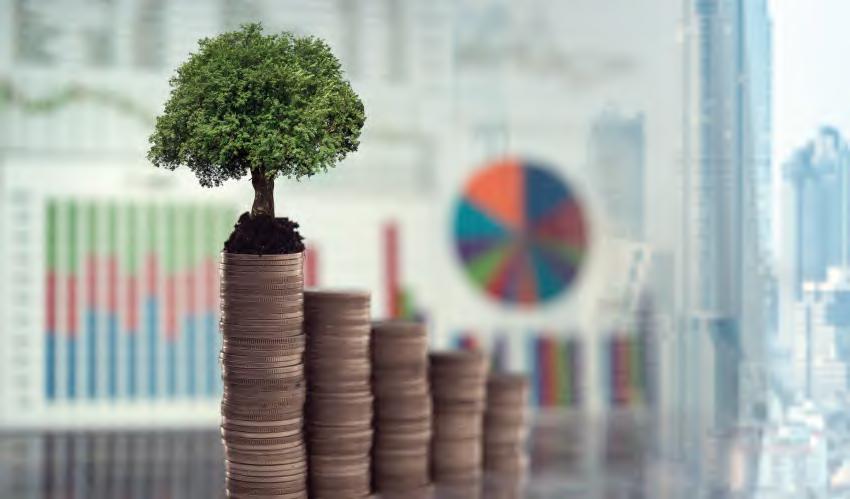
together US$4.5bn of private, public, and development capital from UAE organisations including Abu Dhabi Fund for Development, AMEA Power, Etihad Credit Insurance, and Masdar.
Green bonds
Masdar has also issued green bonds. In October last year, Abu Dhabi Securities Exchange (ADX) welcomed the secondary listing of a US$750mn Green Bond by Masdar. The ten-year bond, which was 5.6 times oversubscribed, carries a 4.9% coupon rate and will mature in July 2033. It aims to fund new clean energy projects. The issuance was
This presidency is committed to unlocking finance to ensure that the global south does not have to choose between development and climate action.
Dr.
Sultan Al Jaber President of COP28
assigned an A2 rating by Moody’s and A+ by Fitch.
Abu Dhabi’s utility company TAQA had also issued green bonds last year. The inaugural green bond worth US$1bn was issued under TAQA’s Green Finance Framework, which was awarded SQS2 (Very Good), sustainability score by Moody’s.
Meanwhile, Bloomberg reported in February this year, that sustainable bond issuance had topped more than a trillion dollars in 2023. This was bolstered by record levels of green bond sales, according to data compiled by Bloomberg.
Impact bond issuance, which includes green, social, sustainability, and sustainability-linked bonds, reached US$939bn in 2023, a 3% increase over the same period the previous year. That was in 2021, when issuance hit US$1.1 trillion.
Sales of green bonds by governments and corporations reached US$575bn in 2023, up from US$573bn in 2021 and a step up from 2022. This was one area where records were broken.
The largest green bond sale of the year was from the Italian government, in April, which totalled €10bn (US$11bn). A total of US$190bn of green bonds were issued by governments throughout 2023.
www.worldfutureenergysummit.com 9 DAY 2 | 17 APRIL 2024 DAILY NEWS
AGENDA: Solar & Clean Energy Forum 18
WHAT’S ON THE
The International Bank of Reconstruction & Development (IBRD) was the largest issuer of sustainability bonds throughout 2023, with nearly US$50bn in sales, according to Bloomberg.
Image source: Canva

“We look forward to working closely with our partners to harness pioneering technologies that transform waste into valuable resources.”
Eng. Ali Al Dhaheri, Managing Director and Chief Executive Officer of Tadweer Group
Achieving the target of tripling renewables
Francois-Xavier Boul, Managing Director of Renewables MENA, ENGIE, discusses what needs to be done to meet the target of tripling renewables, and the MENA region’s energy transition progress.
How do you view the commitment at COP28 to triple renewables by 2030, in terms of its ambition?
The tripling target would bring global renewable energy capacity to at least 11,000 GW in six years. That’s a considerable number, but we’re well on our way, and the world added 50% more renewable capacity in 2023 than the previous year1
There has been a steady increase in renewable energy over the last few decades, and, if you look at this on a time graph, many cynics are extrapolating that growth and assuming that it will continue at the same rate. When you stand on a time graph, you can’t see what’s to your right, but it’s rapidly becoming a hockey stick graph with a huge upturn. It’s already begun, and the energy transition is exponentially growing.
We’ve gone far past the “if”, we’ve established the “how”, and we are now rapidly closing in on the “when”.
What will need to be done to meet this target, in areas such as investment, infrastructure development and supply chain? What do you think will be the main challenges?
Financial sustainability is crucial for accelerating the energy transition and achieving global renewable energy targets. Essential elements include policy support, investment in new processes, and consumer collaboration. These actions must address energy security concerns and rising
anxiety about increasing energy prices, but the transition to cleaner forms of energy will significantly alleviate both of those things.
Crucially, this isn’t just something that rests solely upon the government’s shoulders. Analysis commissioned by the UN High-Level Climate Action Champions concluded that the private sector could deliver 70% of the total investments needed to meet net-zero goals2
It's widely acknowledged that people respond to incentives. While the main incentive for the global population is to reduce annual emissions and create a healthy planet, the business world’s incentive is usually annual reports with a healthy bottom line. However, the financial motivations and rewards are increasingly apparent.
We hear about the cost, but people need to remember that most of those costs for renewable energy are front-loaded, compared to other traditional forms of energy production. The return on investment is potentially phenomenal. For example, green hydrogen could eventually become an addressable market worth US$10 trillion by 2050. And this forecast doesn’t come from a green think tank or sustainable energy company – it’s from Goldman Sachs.
Investors continue to flock to sustainable energy as the must-own asset of the future, and there has been a significant drop in the cost of renewables,
We’ve gone far past the “if”, we’ve established the “how”, and we are now rapidly closing in on the “when”.
Francois-Xavier Boule, Managing Director of Renewables MENA, Engie

Francois-Xavier Boul, Managing Director of Renewables MENA, Engie.
now cheaper than coal, which, for decades, was considered the cheapest source of electricity. While solar got 89% cheaper and wind 70%, coal’s electricity price declined by only 2%3
In 2009, electricity from utility-scale solar photovoltaics cost US$359 per MWh, but that 89% drop is utterly transformative. In early 2009, the price of oil was US$40/barrel; if that had fallen by 89%, it would be US$4.40/barrel today.
At ENGIE, we are working to make the energy transition happen, but also in a way that is affordable and desirable for everyone. Doing the right thing for the environment has never been so profitable, and moving forward, it will only become more so. Challenges remain, of course, but every day at ENGIE, we face them head-on.
How do you view the MENA region’s energy transition achievements and prospects?
It’s perhaps ironic that because the region was the leader in oil and gas for so long, they are now in a strong position as energy experts to finance and facilitate rapid growth in clean energy. These programmes are among the most ambitious energy transition initiatives in the world.
The UAE has invested over US$40bn in clean energy over the last 15 years. It has plans to invest an additional US$160bn in clean and renewable energy sources over the next three decades on the
DAY 2 | 17 APRIL 2024 DAILY NEWS World Future Energy Summit | Daily News 10
22
FLOORPLAN: Who’s where at the show

“With abundant natural resources, a growing population, and rising energy demand, Africa has huge potential to drive energy transition, not just across the continent but also around the world.”
Dietmar Siersdorfer, Managing Director Middle East & Africa, Siemens Energy
road to net zero4. They’re also making a huge impact worldwide, contributing to renewable energy projects in 70 countries.
Likewise, Saudi Arabia aims for 50% of its energy to be generated from renewable sources by 2030, and the Saudi Public Investment Fund has financed around US$400bn since 2016 in alternative energy5
It’s worth noting that renewable energy investment in Egypt and Morocco has been significant in recent years, driven by ambitious renewable energy targets, favourable policy frameworks, and growing interest from domestic and international investors. Given the sharp drop in the cost of renewable energies, a strong growth still lies ahead.
Under that forward-thinking leadership of the regional governments, ENGIE has played a role as an independent water and energy developer with a portfolio currently producing 30.5 GW of power and 5.8mn m3 of drinkable water through desalination.
What is ENGIE’s involvement in the region’s renewable energy developments?
Because ENGIE has been in the region for over 30 years, we’ve been deeply involved in supporting many essential projects, and our asset portfolio is
a testimony to that. We are scaling up our renewable teams in the region and our goal is to participate in all the government and public tenders. Our ambition is to be a key player in this area in the upcoming years.
The area I would like to highlight is less about the big utility scale projects, it’s related to our day-today energy efficiency and sustainable energy solution to our industrial customers in the region, which has a real and significant impact on energy consumption. After all, as the saying goes, the most cost-effective kilowatt-hour is the one we never use.
Our energy efficiency team at Masdar City reduced energy consumption by 30%. Al Zeina, the mixeduse development in Abu Dhabi, wanted to create a sustainable community, and thanks to our hot water pumps the energy consumption of their water heaters was reduced by 73%. We helped our client, Qatar General Electricity & Water Corporation, reduce carbon dioxide emissions by 10,300 tonnes per annum by installing 100 electric vehicle chargers with ENGIE Solutions’ systems. And there are many more examples.
Significantly, it’s not just governments we are working with. For many smaller companies, they
ECOWASTE FORUM:
What’s on the agenda 17
lack the financial capability and technical expertise to implement viable schemes. By creating a technical, commercial, economic and legal framework, we can enable commercial partners to launch ambitious renewable energy projects to help an overall national contribution.
Globally, people are becoming frustrated by words and empty promises, so ENGIE’s whole reason for existing is to deliver progress step-by-step with pragmatism and reliability. You have to show people and companies why they can believe in a sustainable energy transition. I’m proud to say that we have been delivering on that promise.
1International Energy Agency’s (IEA) Renewables 2023 report
2https://www.gfanzero.com/netzerofinancing
3https://ourworldindata.org/cheap-renewablesgrowth
4https://www.zawya.com/en/projects/utilities/uae -to-invest-160bln-in-clean-renewable-energysources-in-next-30-years-yir4evoo
5https://www.arabnews.com/node/1849981/saud i-arabia
How utility companies are decarbonising their operations
Utility companies in the Middle East are decarbonising their operations through a variety of approaches. By centralising the cooling process and utilising more energy-efficient technologies, Tabreed, a district cooling utility company based in the UAE, reduces electricity consumption and carbon emissions associated with air conditioning. This promotes energy efficiency and sustainability in the region's built environment. The company has recently concluded the third phase of its ‘Tasheel’ programme – an extensive retrofit of Variable Frequency Drives (VFDs) to increase energy efficiency and assist in the decarbonisation of its operations.
In Saudi Arabia, Nesma is a diversified conglomerate with interests in district cooling and energy services. Nesma's district cooling systems optimise energy usage and reduce environmental impact compared to conventional air conditioning systems. Emirates Water and Electricity Company (EWEC) has initiated projects to integrate energy storage solutions into its power infrastructure. One notable example is the Noor Abu Dhabi Solar Plant, which includes a significant energy storage component. This project incorporates a largescale battery storage system to store surplus solar energy generated during the day and discharge it during periods of high demand or when solar production is low, thereby enhancing grid stability.
Utilities can modernise their grid infrastructure and invest in energy storage technologies to integrate intermittent renewable energy sources such as solar and wind power. Energy storage systems such as batteries can store excess renewable energy during periods of low demand and release it when needed, helping to stabilise the grid and reduce reliance on fossil fuel-based generation.
Governmental utility companies are aiding this process. Dubai’s electricity and water company, DEWA, has been investing in smart grid technologies to transform its traditional electrical grid into a more intelligent and adaptive infrastructure. This includes the deployment of advanced metering infrastructure (AMI), which enables remote monitoring and management of electricity consumption, enhances billing accuracy, and facilitates demand-side management programmes. It has also implemented grid automation and control systems to improve reliability, and reduce outage durations. This empowers consumers as well.
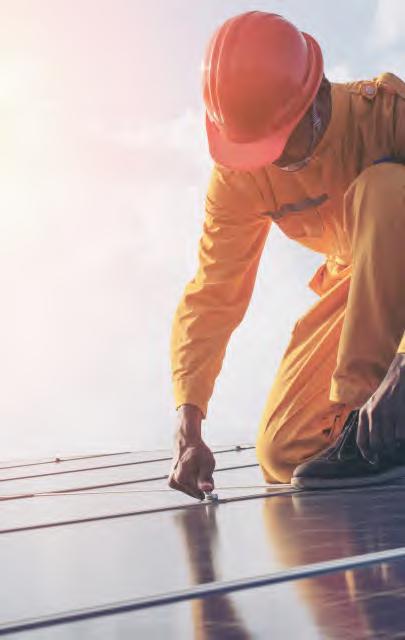
Utilities can modernise their grid infrastructure and invest in energy storage technologies to integrate intermittent renewable energy sources.
www.worldfutureenergysummit.com 11 DAY 2 | 17 APRIL 2024 DAILY NEWS

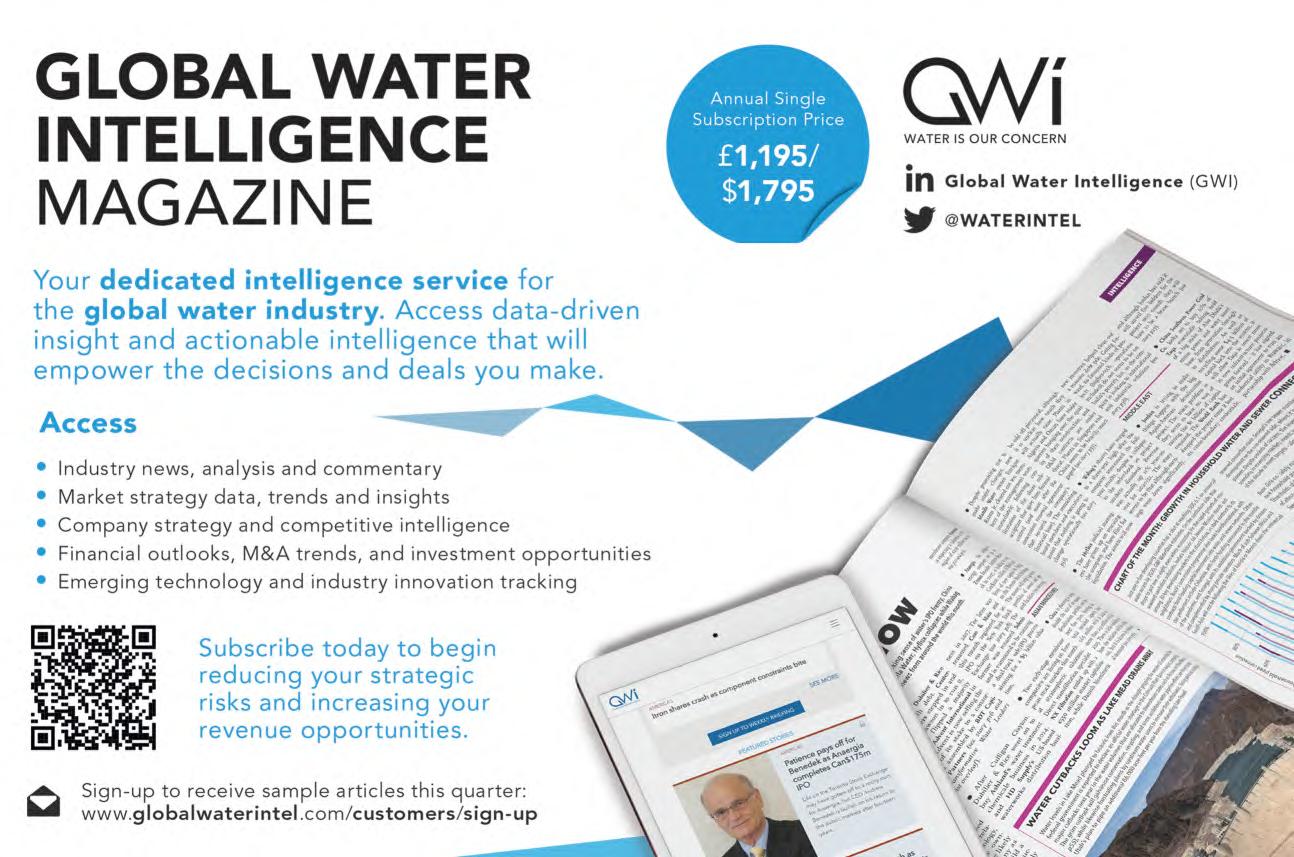

“For ACWA Power, ESG is at the heart of everything we do. Guided by the Kingdom’s Vision 2030, we are dedicated to supporting a rapid and responsible transition to cleaner sources of energy.”
Marco Arcelli, CEO, ACWA Power
Shining a light on the power of solar
John van Zuylen, CEO of Africa Solar Industry Association (AFSIA), discusses how solar is fundamentally changing the energy landscape in Africa and supporting essential services to support the burgeoning population.
According to AFSIA’s Annual Solar Outlook 2024 there has been an ‘unprecedented surge in demand and innovation’ around Africa’s solar industry, primarily driven by a collective consciousness towards sustainable energy and the pressing need to address power deficits.
Explaining this further, van Zuylen remarked, “Solar expansion has moved rapidly across the world and Africa is no different. Roughly speaking, there was around 350 GW of solar installed around the world in 2023, compared to 240 GW from the year before. In Africa, this went up by 3.7 GW (at least of projects we have identified, and there are certainly more), which is up from the previous record of 3.1 GW in 2022.
“While this means the continent was only responsible for 1% of all solar installed across the globe in 2023, it must be understood that the situation here is crucially different from the rest of the world, and there is similar parallel growth. We have identified 16.3 GW peak total accumulative of solar projects currently in operation on the continent, but there is 220 GW peak of solar at various stages of development. Not every project will eventually be built, but you can see this growth. The multiplier is similar in regards to storage. We have identified 1.2 GWh of storage installed in Africa and we know of 10 GW of storage under development, which does not include the new tender recently launched in South Africa for 2.5 GWh.”
Fundamental differences
Returning to the differences between Africa and the rest of the world, van Zuylen highlighted the situation in Europe where significant solar capacity has been installed over the last year. This has, however, been mostly driven by government policies and tenders in light of the crisis in Eastern Europe.
“In Africa, we see the exact opposite. There are fewer government tendered projects and the capacity additions are mainly private commercial and industrial (C&I) projects. This is why I am so bullish about the market in Africa. Solar and storage have reached such a low price point that it unlocks possibilities for companies to make the decision to procure their own electricity. Previously, the need was there but it was not affordable. Now, we have reached a point of affordability in many places and, with every day that passes, more countries reach the stage where solar and storage is the economical option.
“I would say that this is a risk for national utilities on the continent. With grids struggling to reach all corners of many countries, an increasing number of private people and companies are deciding to go solo and may never return to the grid. This creates a snowball effect and, if it continues to progress, I can’t see a way back for them.”
Changing lives
Switching his attention to the upcoming World Future Energy Summit, van Zuylen expressed his excitement at returning to the conference. This year, the CEO will be speaking at the Climate & Environment Conference and has chosen to focus on the role of solar energy in improving healthcare in Africa.
“There are approximately 100,000 public healthcare facilities across the continent and only 28% of those have access to somewhat reliable electricity,” van Zuylen commented. “During my presentation I
Solar expansion has moved rapidly across the world, and Africa is no different.
John van Zuylen CEO of AFSIA

John van Zuylen, CEO of Africa Solar Industry Association.
will be focusing on two forms of productive use of electricity (PUE) around solar which are making enormous differences to people’s lives.
“The first is a solar system connected to a vaccine fridge which allows every single primary healthcare centre with no connections to the grid to actually host vaccines under appropriate conditions and at a competitive cost. This has become particularly pertinent in the post-Covid environment, but there is a multitude of diseases that are a cause for a lot of mortality and require vaccines.
“Another significant cause of mortality is childbirth. Statistically, a large proportion of deliveries happen at night and without electricity there is no (or poor) lighting. Conducting a delivery in this way can cause a multitude of problems for the doctor and solar systems can change this. It might seem small, but actually this changes everything.”
“This year I really wanted to talk to the audience about something that they are possibly not very aware of,” van Zuylen said He added, “I have been working in the solar industry for almost 20 years now and there are really two things that keep driving me on. The first is that it is a growing industry with an increasing number of innovative people getting involved. There are always new people to meet and the Summit is one of the best places to do that. For the second, I would say I have a ‘wow’ moment once a year where I encounter a new solution or a genius idea. Even after all this time I have spent in the industry, you would think you have seen it all but, no, you’ve never seen it all. There is always somebody coming up with a new concept, and there is a high chance that you might encounter this person and the idea at the Summit.”
www.worldfutureenergysummit.com 13 DAY 2 | 17 APRIL 2024 DAILY NEWS GREEN FINANCE: Latest developments 09
